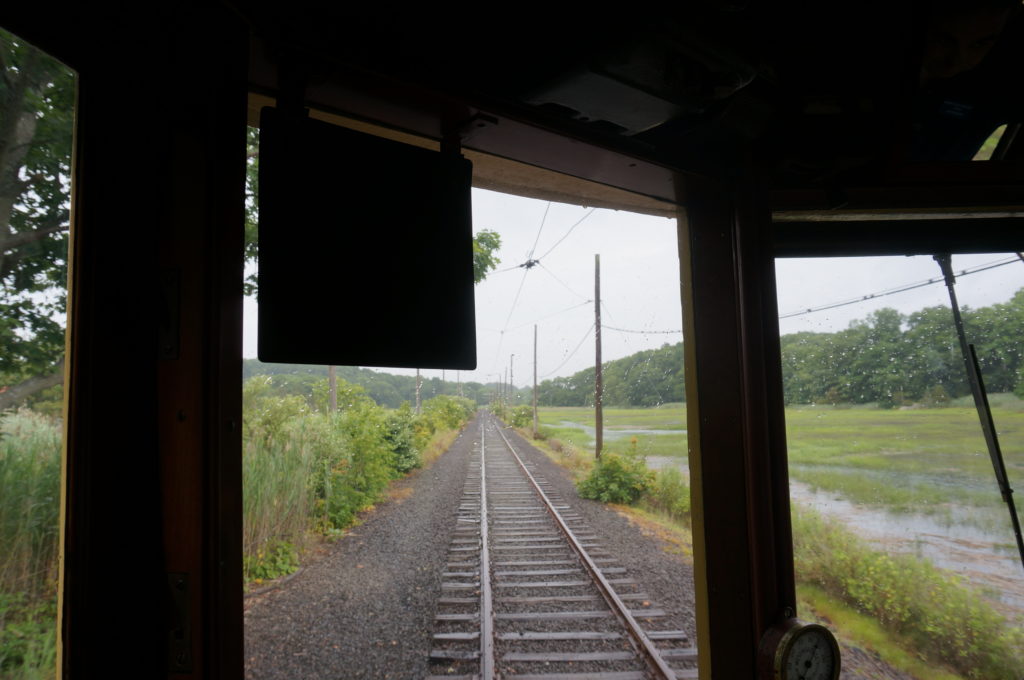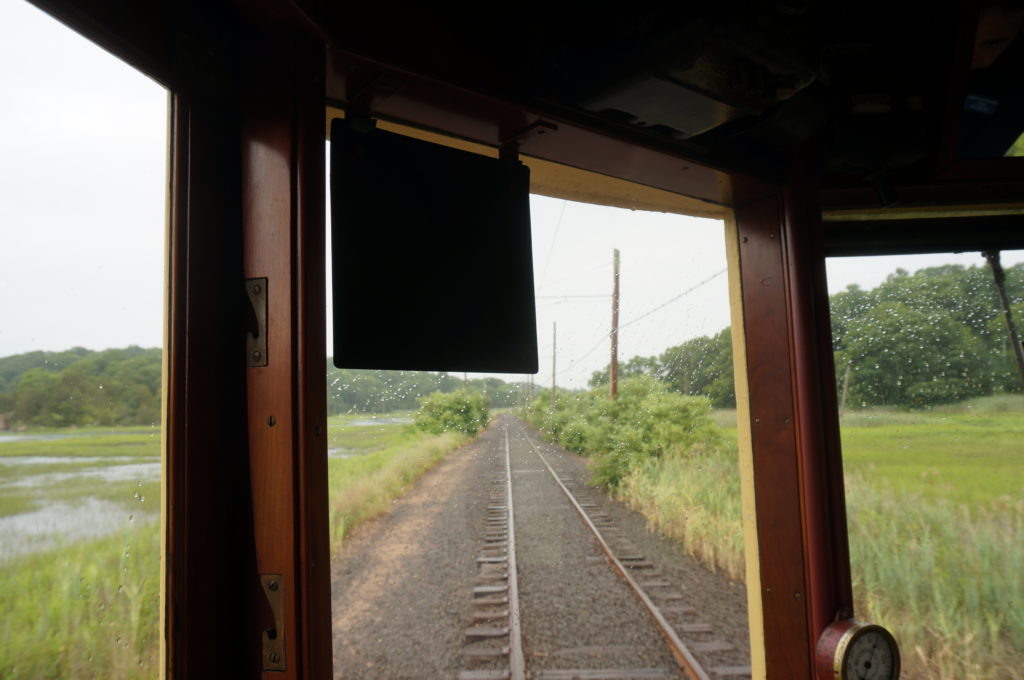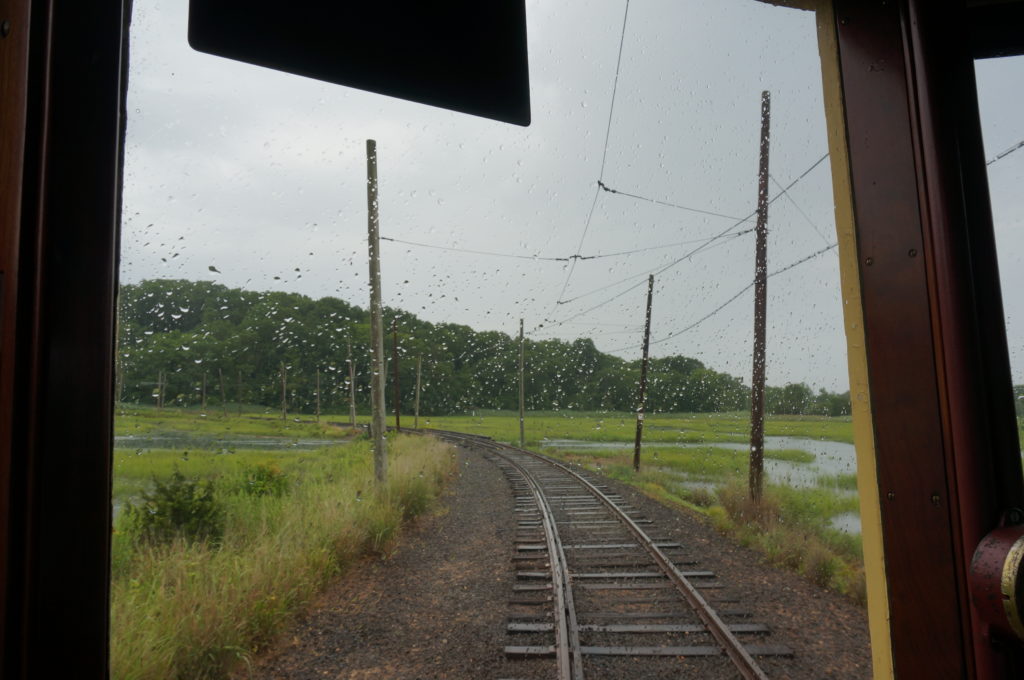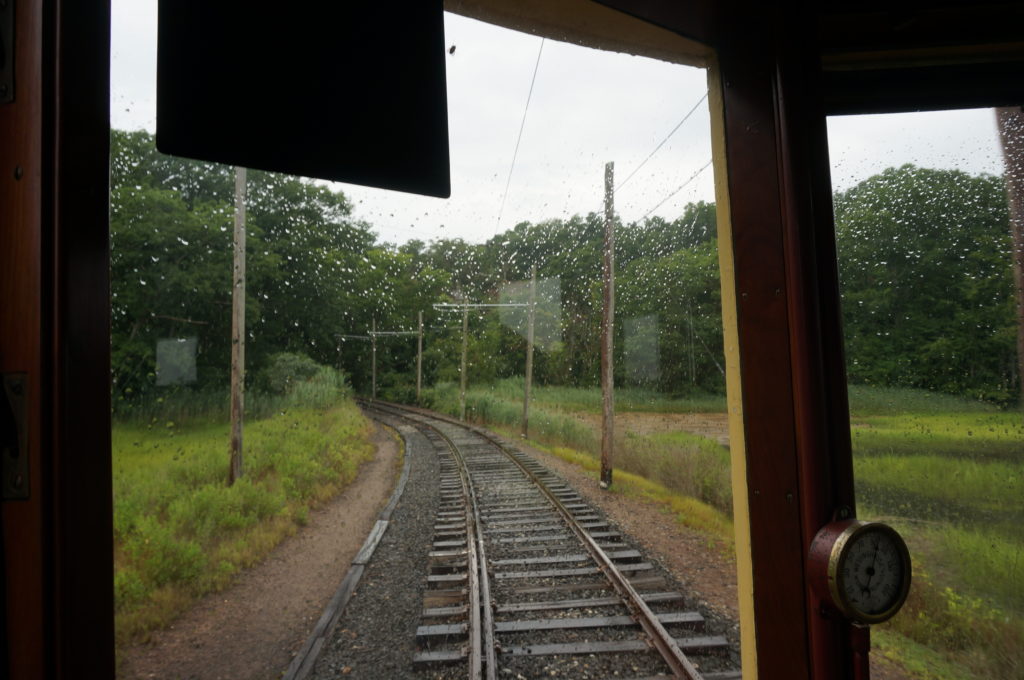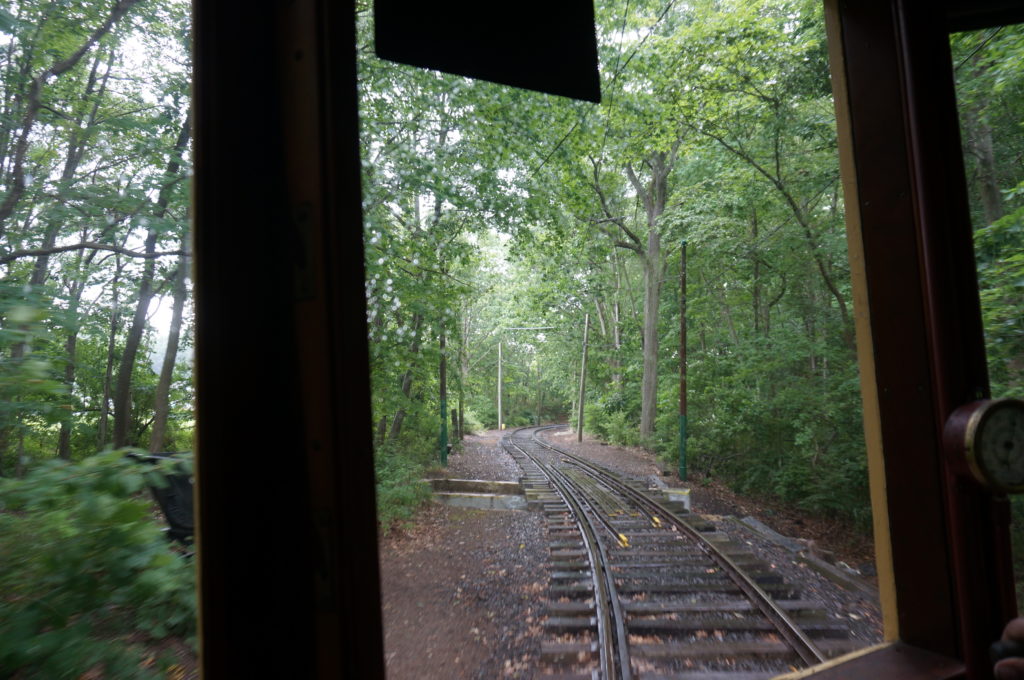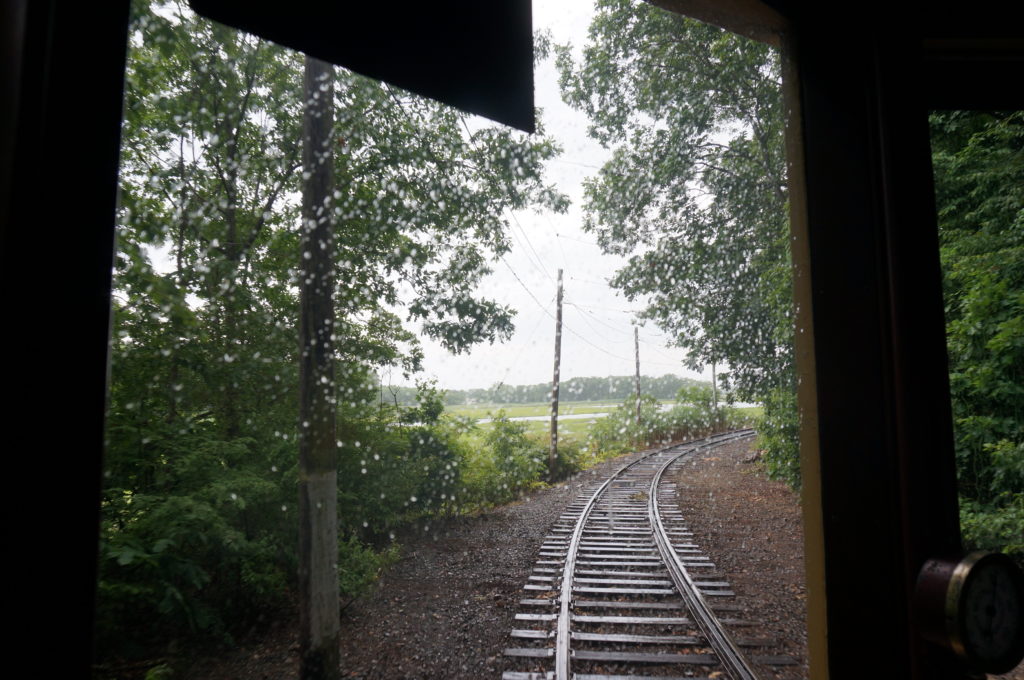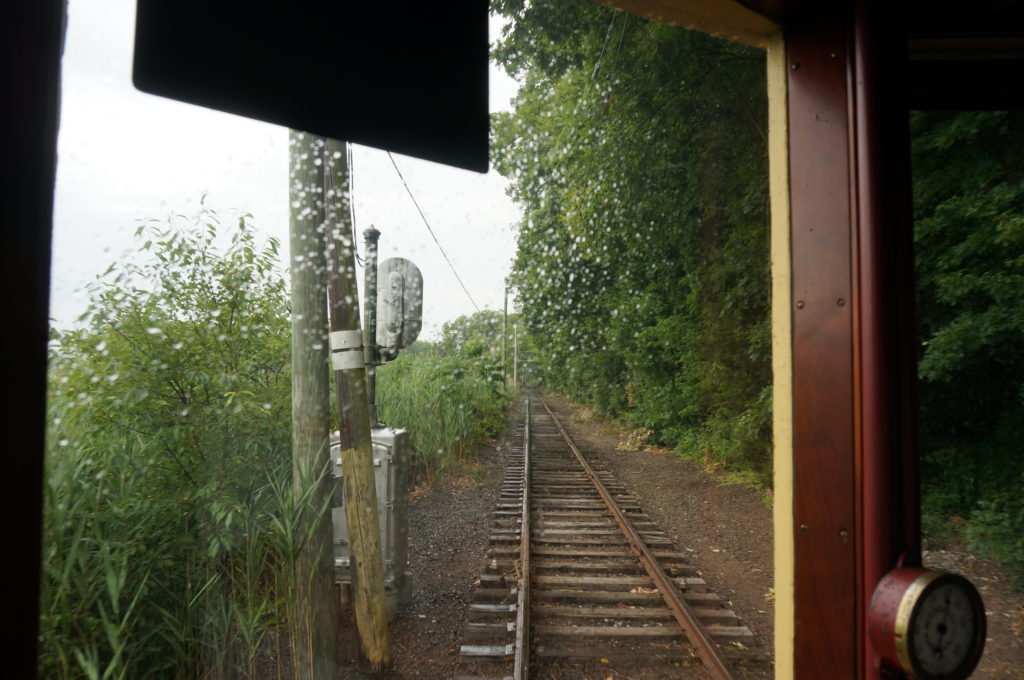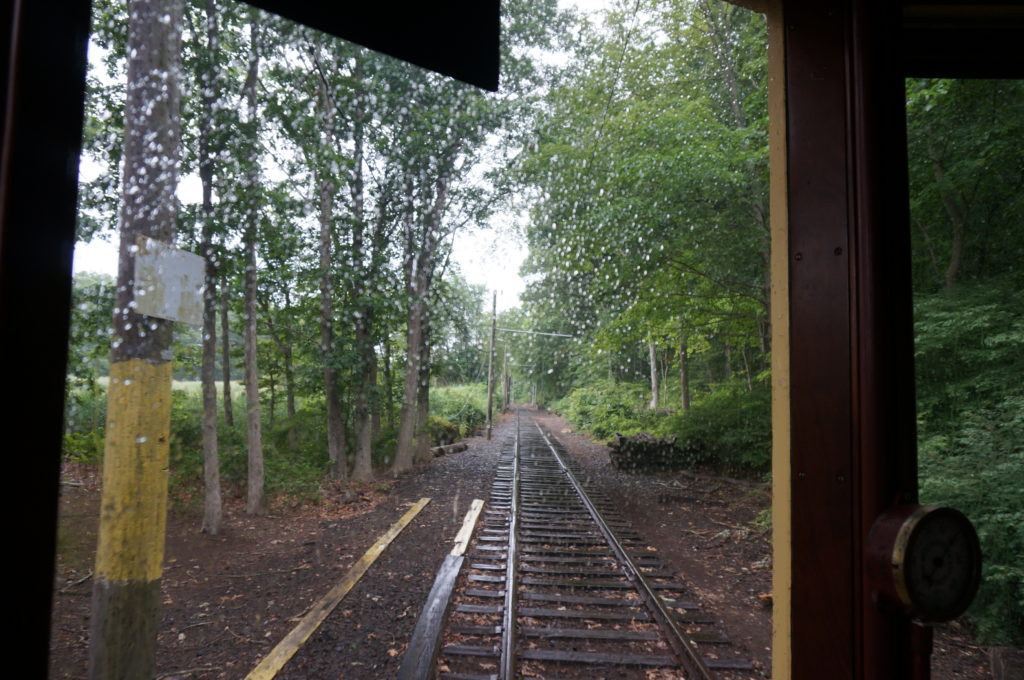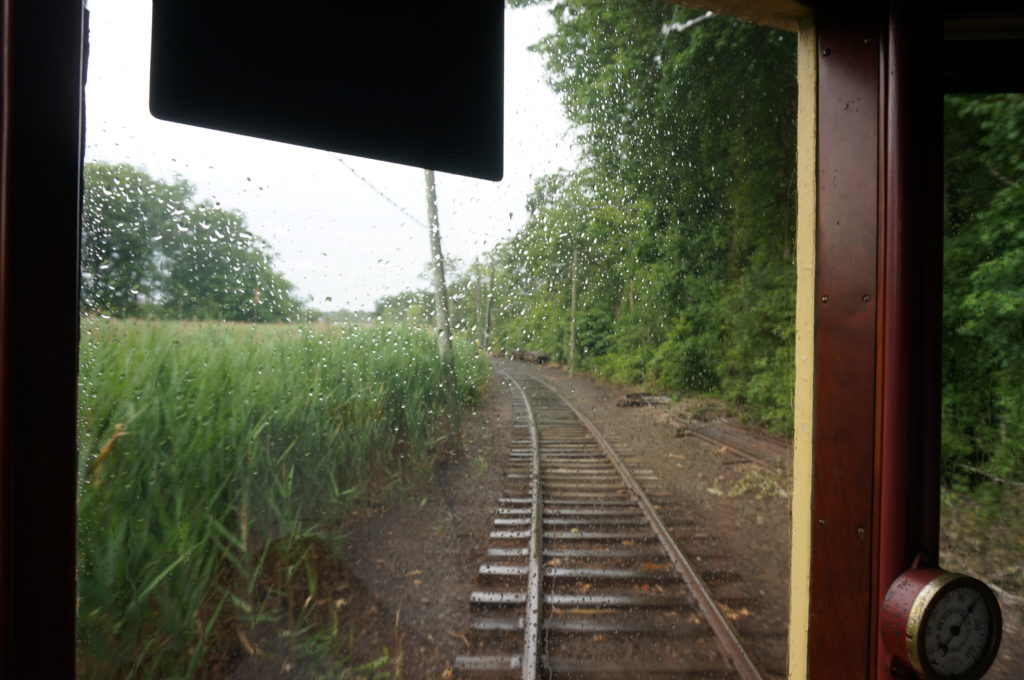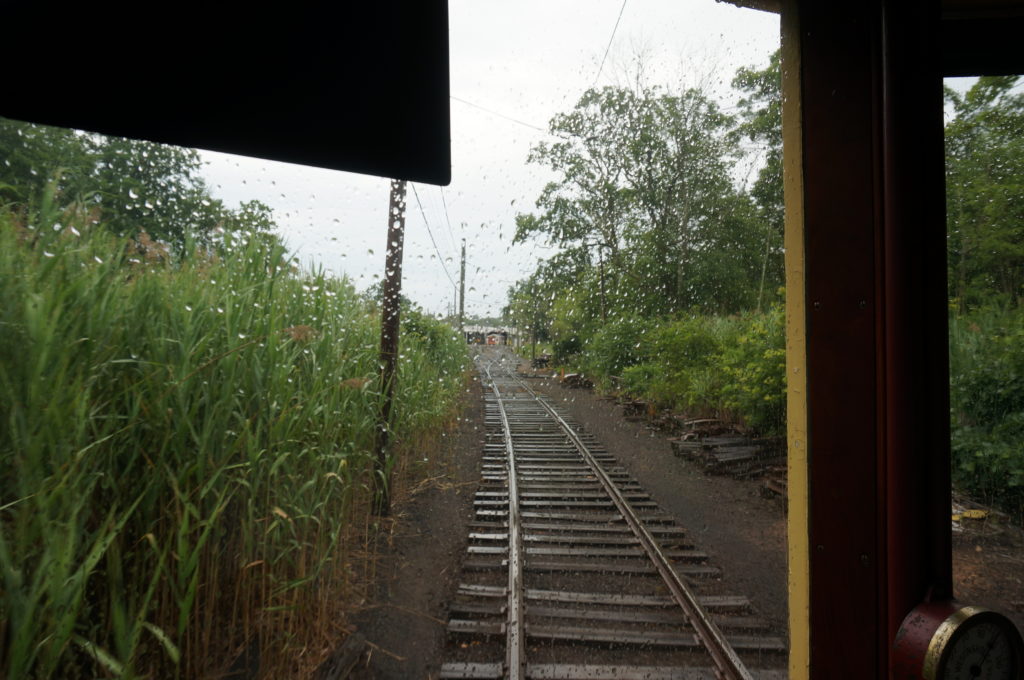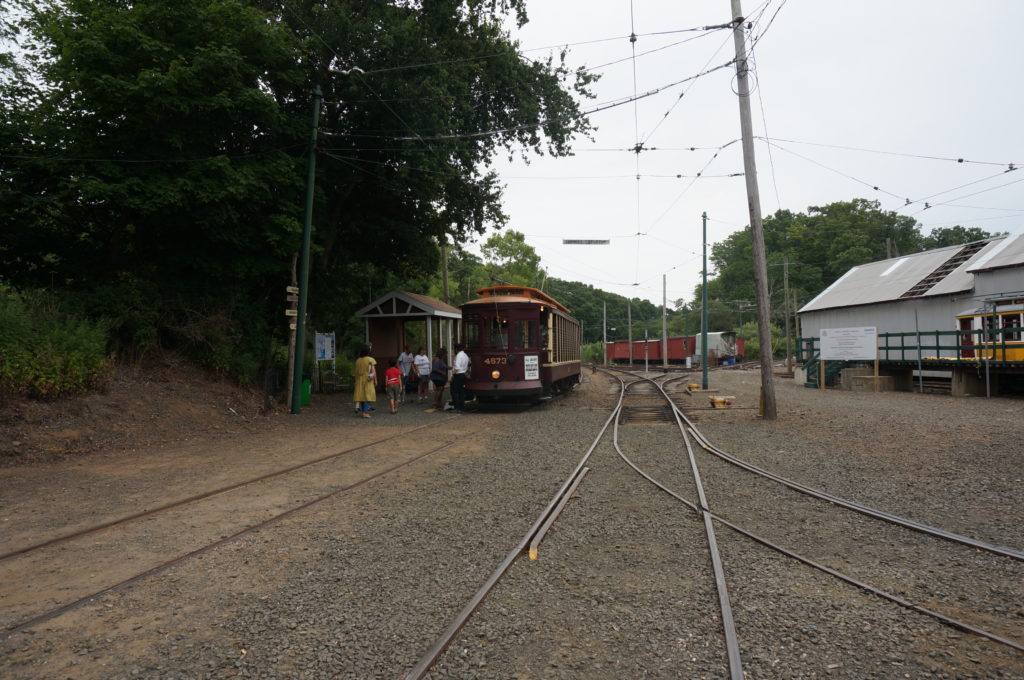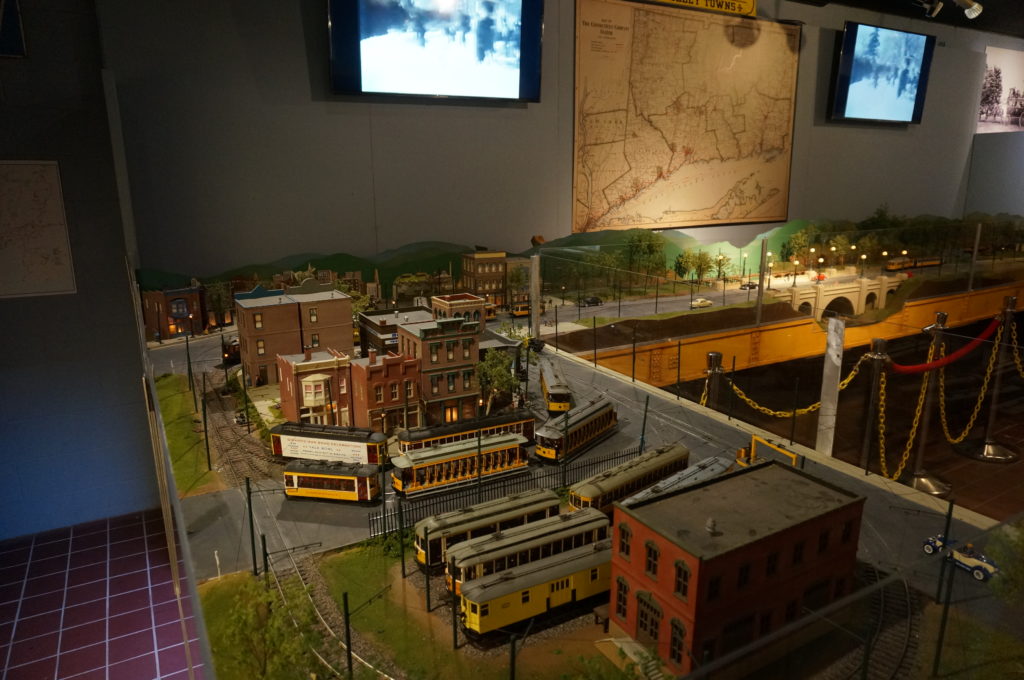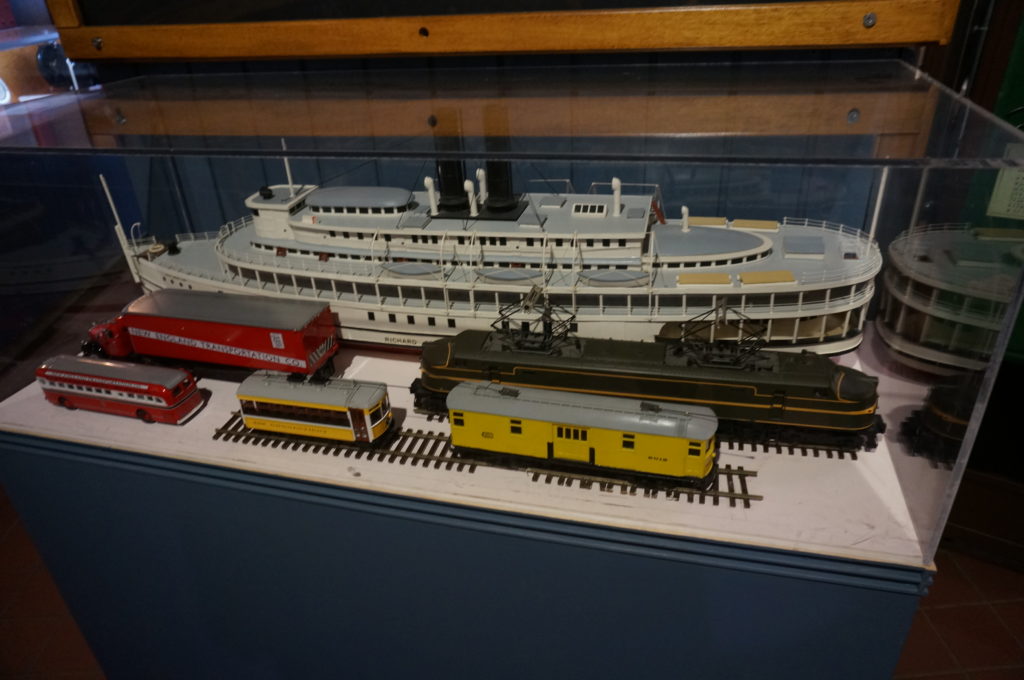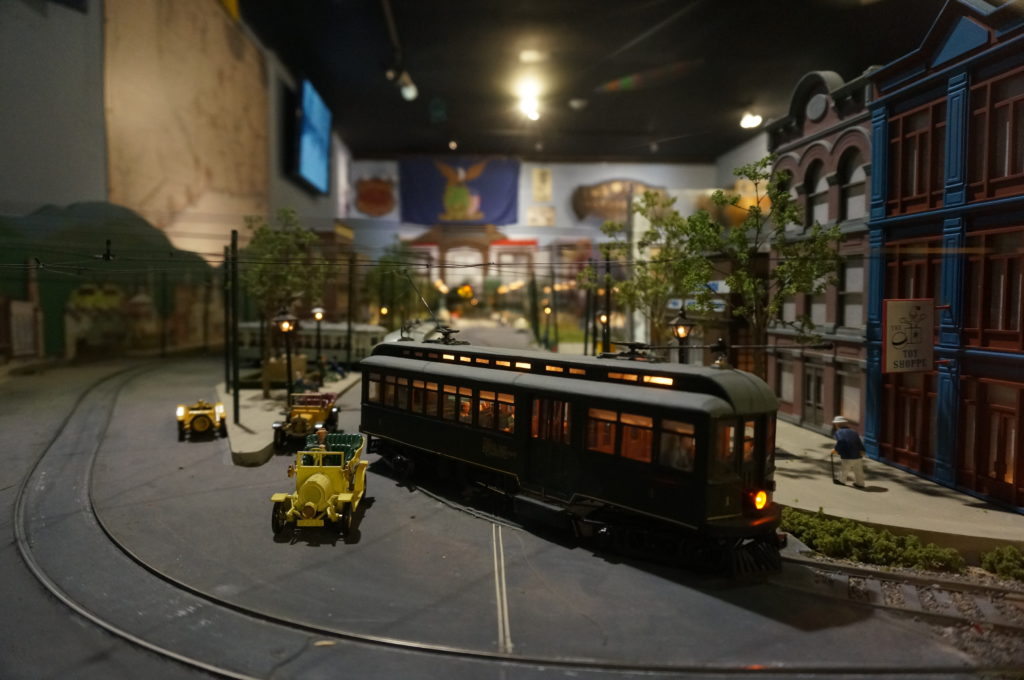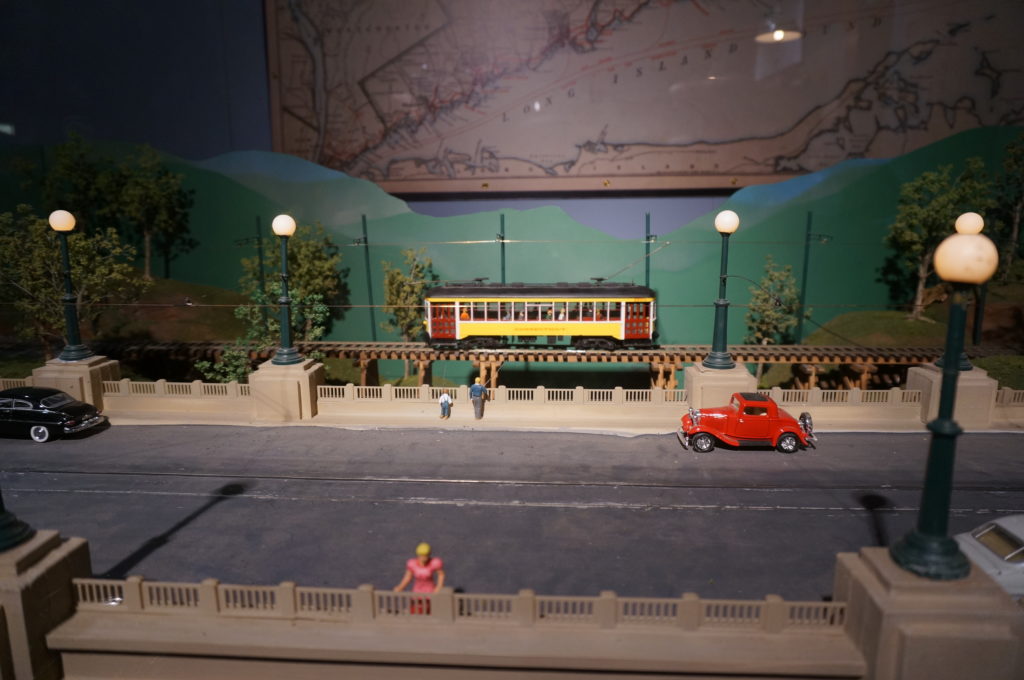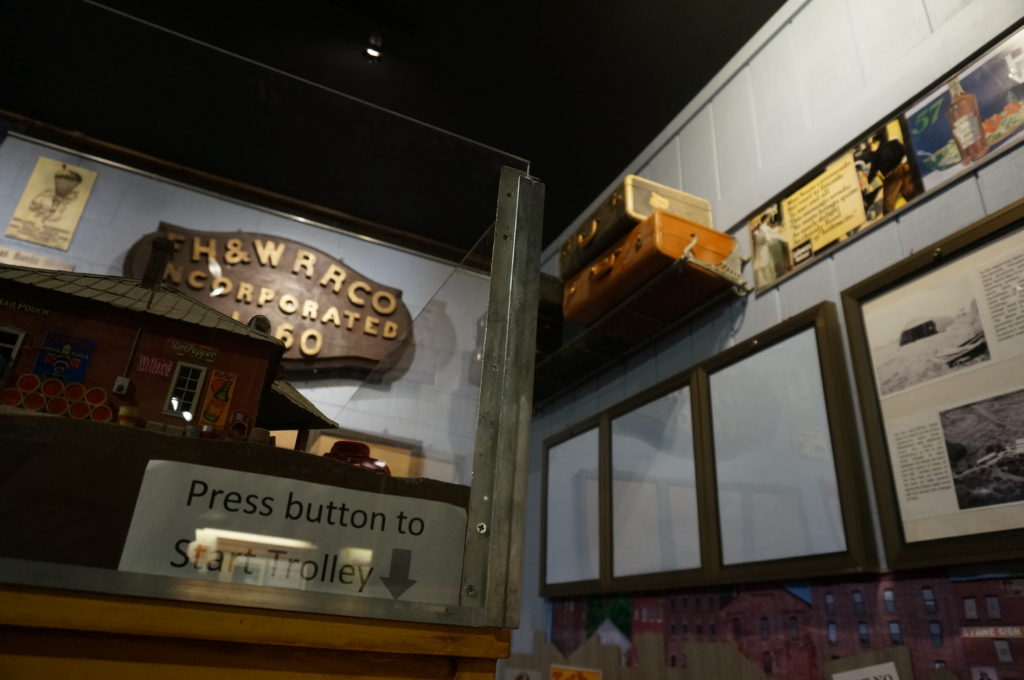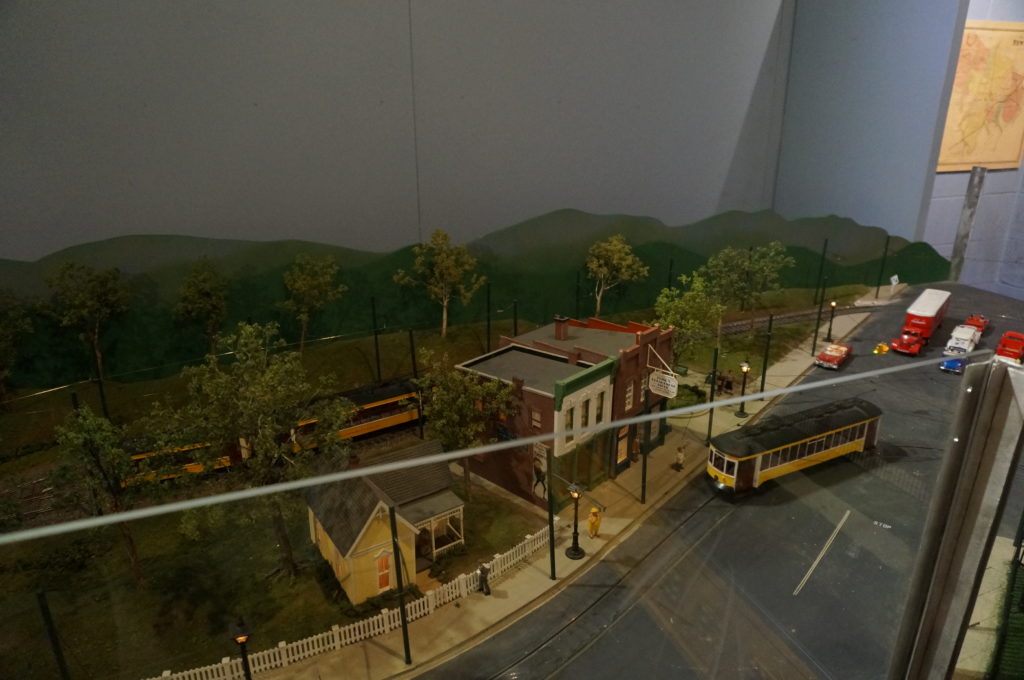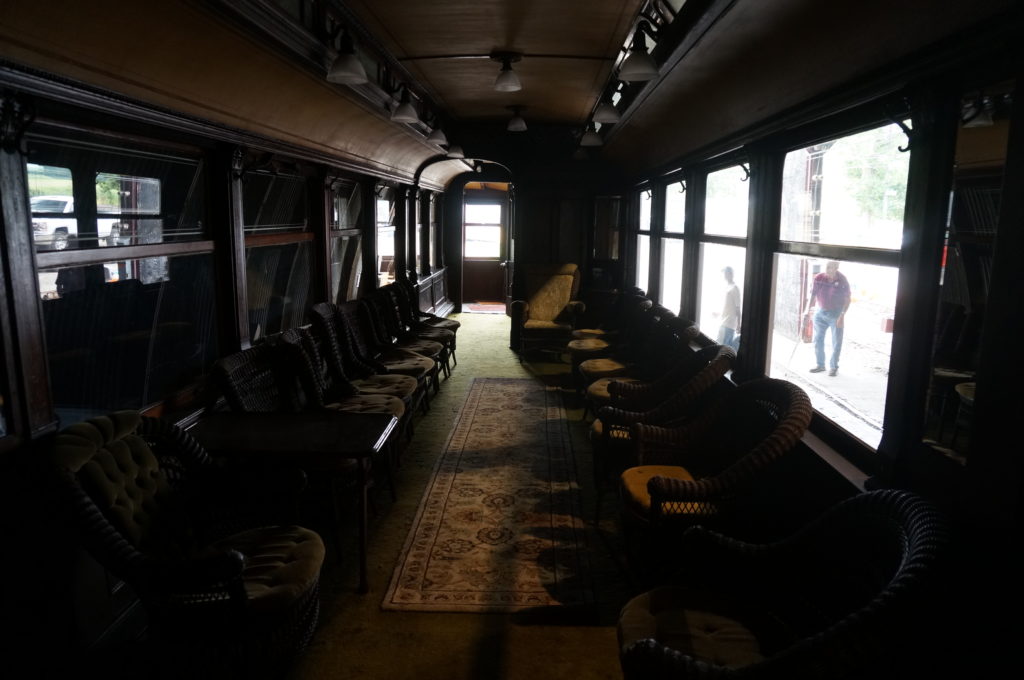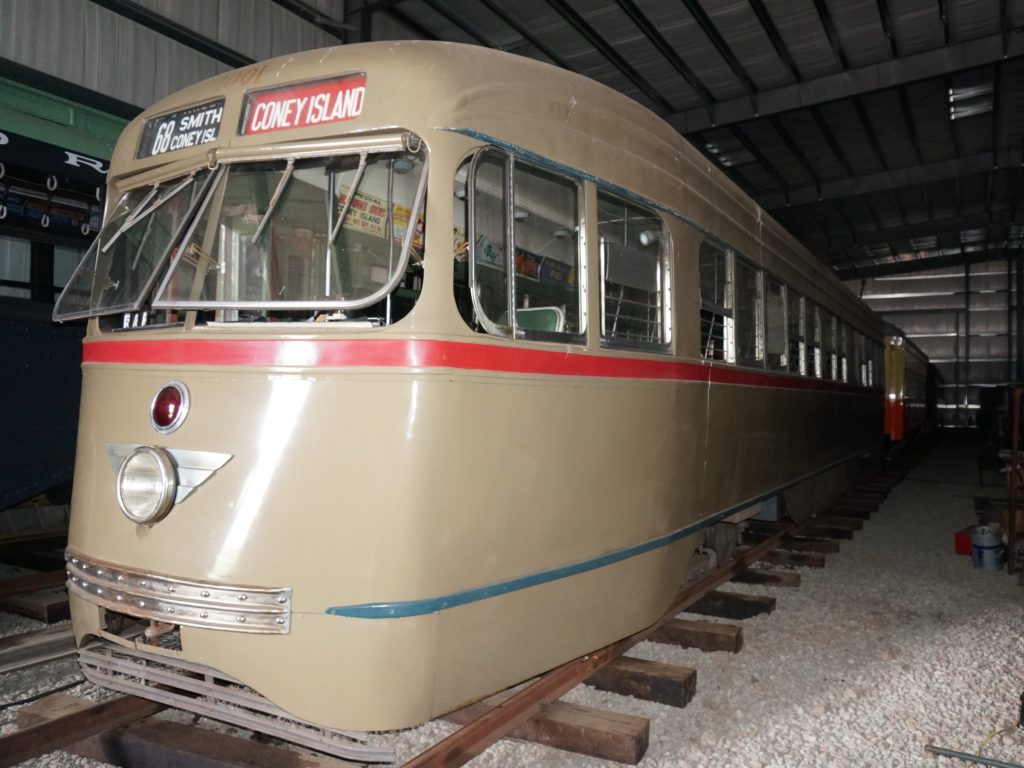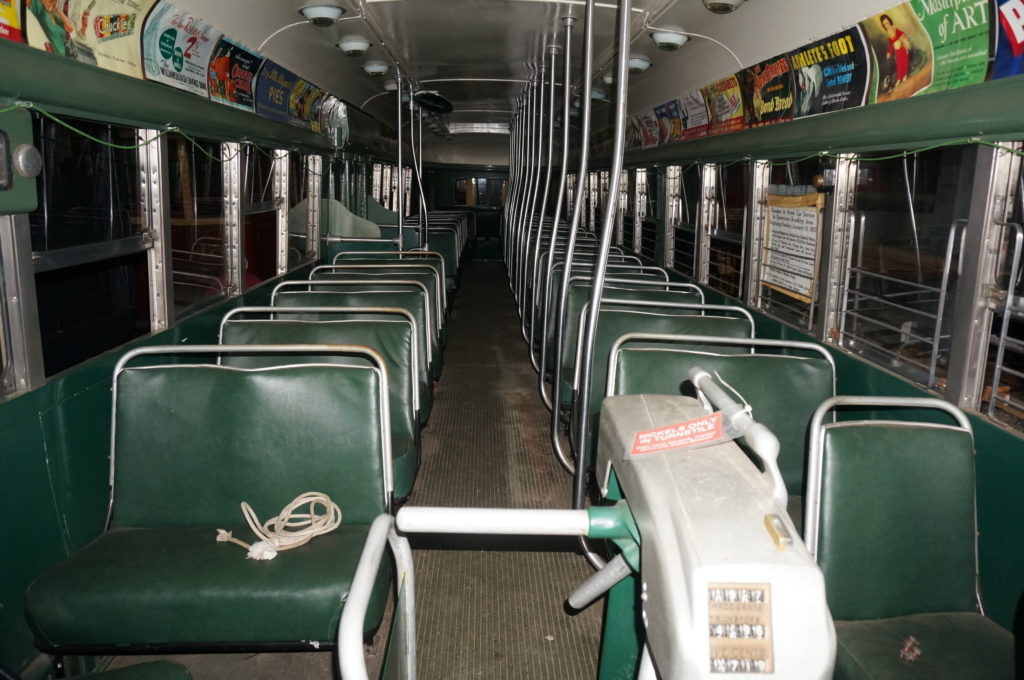Welcome back… I guess. Neither of us were really able to write for a while, and nor were we inspired. For now, here’s a report on the Shoreline Trolley Museum in East Haven Connecticut, which I visited on July 16th of this year. I am aware that there’s not much of “this year” left, and for a blog of this kind, this type of frequency is unacceptable, but… finishing this before the end of the year was a goal for me recently. And something is better than nothing at all, right?
Let’s get to it!
Overview
The Shoreline Trolley Museum, sometimes also called the Branford Electric Railway, is a transit museum in East Haven, which is, unsurprisingly, just east of New Haven in Connecticut (in the United States). However, most of the actual museum is in Branford, which is just east of East Haven. The museum’s collection is focused on the Northeastern United States, with a smidge of general North American items. There is no significant overseas collection. The vehicle collection is composed of your standard mix of streetcars, rapid transit, and buses/trolleybuses.
One of the museum’s marketing statements is “The oldest continuously running suburban trolley line in the United States”. Which, by itself, is a fun statement, since suburbanity is not objective, New Orleans is the oldest continuous in the US, and the entire thing sounds strangely similar to “The world’s oldest transit museum” of the similarly named Seashore Trolley Museum some 300 kilometers to the northeast.
Anyway, enough pedantry, the museum’s open 11 to 15-16,1 every day of the week except Monday, I suspect seasonally. However, I was told that you can be served practically any time if you spot a friendly volunteer.
Positioning
If there’s anything to distinguish the Shoreline Trolley Museum from other New English trolley museums, it’s the fact that it’s in an urban locality.2 The museum is at the end of an unsuspecting suburban road.
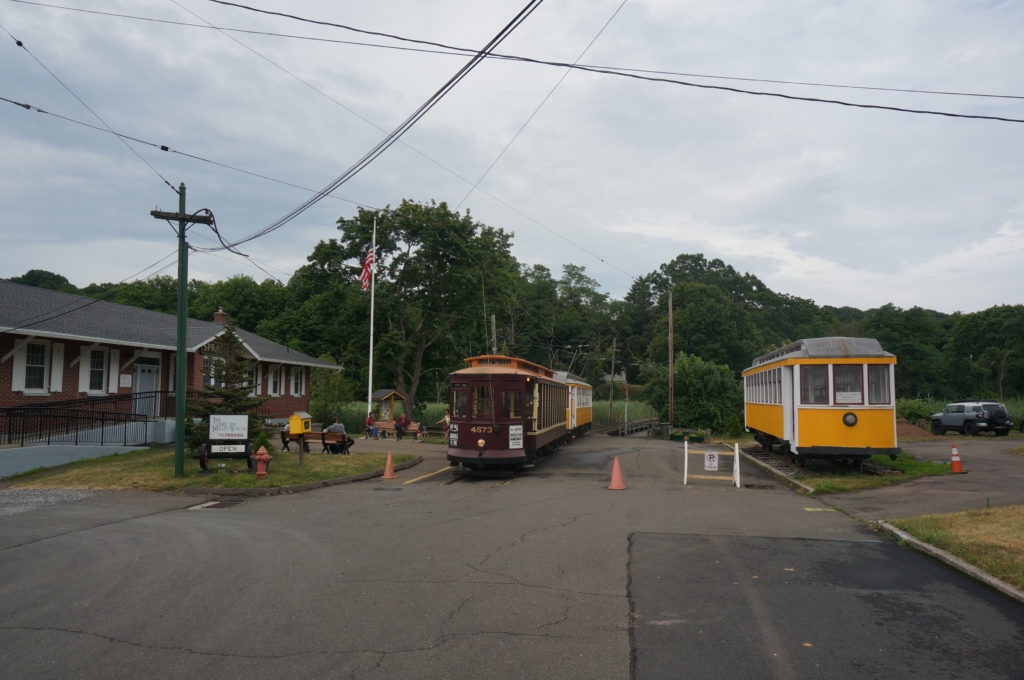
The main campus of the museum is across a river from the main entrance. The municipal boundary of East Haven and Branford is on the river, with the main campus in Branford and the visitor center in East Haven. This is why the postal address is East Haven but the museum is also known as the Branford Electric Railway.
The operating line of the museum starts at the visitor center, practically on the street. From there, it crosses the river and proceeds to curve towards the main campus, passing to the east of it just after. At the southern end of the campus, there is a stop. The line then proceeds south, with a marsh to its west and a forest to its east. After that, there’s an S-curve through the marsh followed by another straight section, this time entirely in the marsh. The line terminates at a small wooden platform, right next to the intersection of Clark Avenue and Court Street in Branford’s Short Beach neighborhood.3 This line, while not particularly long at under 3 kilometers, is quite varied and is different from what you’d expect of streetcar museums.
Here are cabview pictures, going from Short Beach to the museum campus:
The museum has quite a wide array of barns. As can be expected, most are not open to the public. The barns kind of intrigued me for being in a cluster. Further down in the post we will go over the ones I got to see.
Map
Since the museum doesn’t produce their own map, I had to. While I didn’t use the proper tools, it’s still a decent result, if I may say so myself.
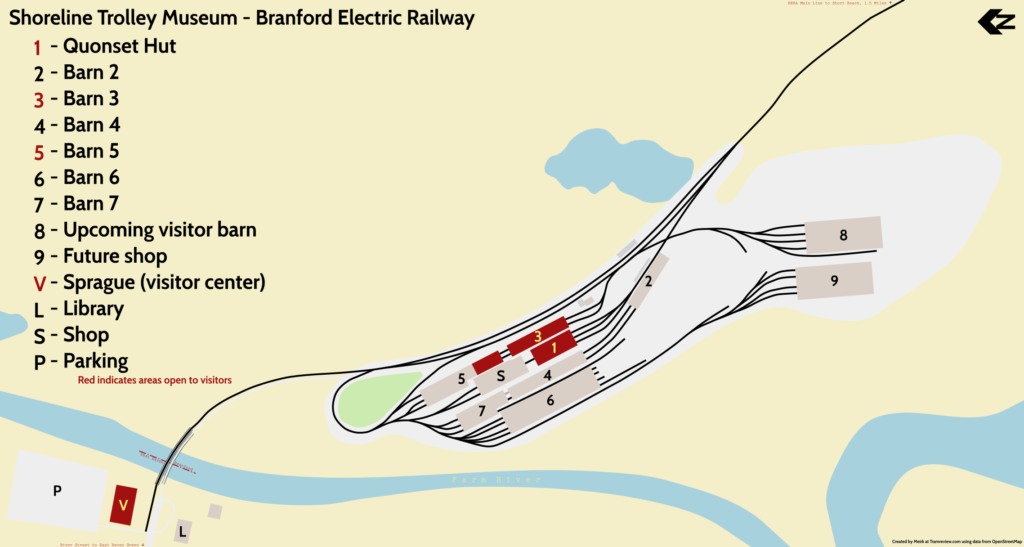
History
Pre-BERA
For a museum located on a predating right-of-way, the history obviously streches beyond the museum’s founding. One of the articles I’m referencing starts from the founding of Branford and East Haven in 1644, okay then… Anyway, I think it’s worth mentioning that the first horsecar line in New Haven ran in 1861, and that the system electrified starting 1892. The first streetcar to run in East Haven did so in 1894.
The relevant line on which the museum is located today was chartered in 1897 as the Branford Electric Railway Company.4 The company’s purpose was to construct a line from Branford to connect to the streetcar system in New Haven. The line likely passed via the marshes in the manner it did, relative to more direct routing into Branford, in order to serve the beach. Prior to the opening of the streetcar line, the company merged with the local utility company, the Branford Electric Company, to form the Branford Lighting & Water Company. Corporate consolidation on the New Haven side also occured.
The line opened to Short Beach on July 31st, 1900, and all the way to its further terminus in Branford on August 17th, under an arrangement whereby Branford Lighting & Water would maintain the line, and the conectee railroad, the Fair Haven & Westerville, would supply power and operate its own cars. It is said that frequency was every 24 minutes from about 6:30 to about 23:00.
Apparently, the line was quite popular after its opening.
There was a minor derailment on the line at around December 1901, followed by a head-on collision which killed one of the motormen in July 1902. I have to say this definitely doesn’t paint a picture of a safe line…
Following the collision, portions of the line were double tracked by 1903.
In 1902, the Fair Haven & Westerville, then operator of the line, was purchased by the New Haven Railroad-controlled Consolidated Railway Company. The Consolidated Railway Company had a strong interest in acquiring the line from Branford Lighting & Water, however the utility company was only willing to sell wholesale, which it did in 1905. Thus the Branford line was fully integrated into the New Haven system. In 1907, the Consolidated Railway changed its name to the Connecticut Company, as it kept gobbling up street railways throughout the state on its monopolising mission.
A single track extension of the Branford line to Stony Creek, in southeastern Branford, opened in June 1907, and ran at half-frequency. This extension had been considered in the original proposal for the line, however was not constructed then.
The line did not continue to be free of accidents throughout this time, however. On an evening in January 1906, a man in a sack laying on the right of way was struck. This was suspected to be a murder by whoever placed the man there, however it was ruled accidental. Following this, in June 1909, there was another head-on collision, with some injuries but not fatalities. A mere month later, a conductor slipped off the running board5 of an open bench car and was hurt. As you can see, this is why modern museums, whenever they run open bench cars, don’t have people walking on the running boards. This incident was followed by yet another head-on collision, this time with one fatality. As you can also see, early 20th century suburban streetcars were quite bad at being safe; a major reason for this was likely the absence of any sort of signaling system (which is something present on modern museum lines).
To finish it off, during an ice storm in February 1915, a car on the embankment portion of the line derailed into the Long Island Sound.
In 1919, a competing bus service was started inland. The Connecticut Company tried to compete with said bus service by running their own, however they decided to end it in 1925.
In 1924, the frequencies on the line were cut from every 24 minutes on the core section to every 30 minutes, evidencing slowly declining ridership.
By 1931, rumors were circulating that the Branford line may be abandoned, which were later supported by ConnCo. They cited the rise of the automobile, improving road qualities, and the resulting lowered ridership and uneconomicality of running a suburban streetcar service of this kind. It is noted that ridership on the line remained “fairly good” year round, even after the hit of the Great Depression on businesses at Short Beach.
Instances of automobile collisions started to occur at around this time…
Given these conditions, and also given that it probably wasn’t the best run company, the Connecticut Company filed for bankruptcy in 1935. Associated with these processes, the Branford line was cut back from Stony Creek to Branford in March 1937. The ConnCo would’ve closed the entire line, however a bridge which would’ve been used by buses in order to most closely replicate the route in the area was unsuitable for them, meaning ConnCo had to wait for the bridge’s replacement. The bridge would only be replaced in 1942.
In August 1941 the line was cut to the outskirts of Branford as part of the replacement of a different bridge in town.
In December 1941 the US was drawn into World War II.6 While this was a very distant event to a suburban streetcar line, it had a significant impact on it. With the country thrown into the wartime economy and the commencement of rations on various materials, including rubber and gasoline needed for buses, bus conversion was undesirable and outright prohibited from 1942 to 1945.7
By this time, New Haven was the last remaining city with streetcars in Connecticut, and its system was certainly well utilised during the war, with (apparently) the reinstatement of previously mothballed lines, and bringing of old cars out of storage. ConnCo kept the maintenance to a functional minimum, since they sought bus conversion.
Following the war in 1945, the New Haven streetcar lines would have a few more years due to backlogged bus orders throughout the country.
In 1946 the Branford line was again cut, this time to Short Beach, just beyond the current end of the museum line, due to street reconstruction.
On March 8th 1947 the last revenue car made the trip from Short Beach, and the line was replaced by buses.
By this time however, the American streetcar preservation movement, sparking at Seashore in the late 30s, gained traction in New England.
Post-BERA
The Branford Electric Railway Association was founded in 1945, following the identification of a portion of the Branford line as being suitable for a trolley museum by an enthusiast group. BERA was able to buy the relevant private right-of-way section of the line from ConnCo for $3500, considered a gesture of goodwill, since they would have been able to gain more from selling the line for scrap. BERA took over the line on March 9th 1947, the day after the end of revenue operations. Thus the line remained in continuous service between the transit operator and the museum, a rarity for American trolley museums, which are typically either on top of a long abandoned right-of-way, or are distant from a right-of-way.
Additionally a rarity was the continuous goodwill of ConnCo, which retained track and electrical connections to the rest of its (closing) New Haven system for over a year after the museum’s opening, allowing for the easy shipment of acquired cars and their temporary storage at ConnCo’s James Street Carhouse.8 As you can see, for this one year, Shoreline was a system attached museum, which, while common in Europe, is exceedingly rare in North America.
When you think I’d be done with pointing out the uniquenesses of this operation, I’ll say that it is also notable that, if the source is to be trusted, that Shoreline was the only operating trolley museum in the world at the time of its opening. This is since at this point, while a few museums existed, none had actually run cars, only held them in storage, not having the resources to run an operating line, while Shoreline immediately started with one.
Following this dramatic start, the museum chose to single track its line for economical reasons, with the second track space on the trestle at the entrance converted to a path.
The first barn and yard were up by 1948.
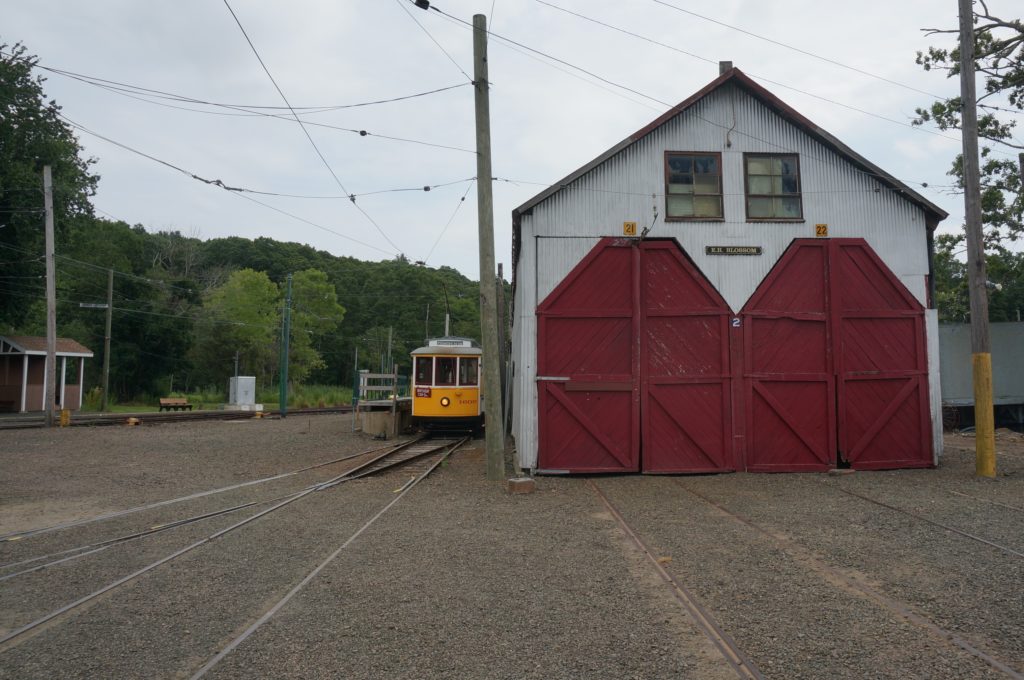
And… this is where my research runs dry. While there is remarkably good documentation of the museum’s line prior to its founding, and of the museum’s early years, I couldn’t find much of anything for dates after 1950.
I can assure you though, in 1983 the museum was attested as using its line to its current length, and having practically all current buildings sans Barns 8 and 9 in place.
I also do know that the museum suffered significant flood damage during Hurricane Irene in 2011 (it’s on a coastal marsh after all). I’ve heard stories of cars being run off the end of the line on River Street in order to put them on higher ground. Construction on Barns 8 and 9 was started in 2013 to not only house more artifacts, but also in order to raise parts of the museum as a protection from flooding. Construction on Barns 8 and 9 seems to have been practically done by 2017.
When I visited, however, about 11 years after the flooding, even though people kept mentioning the event, I wouldn’t have known whether any flooding happened at any point from just looking at it.
Further Detail
Operating Fleet
The day I was at the museum, July 16th, they had two cars in the operating fleet, Connecticut Company 865, and Brooklyn Rapid Transit 4573.
Connecticut Company 865
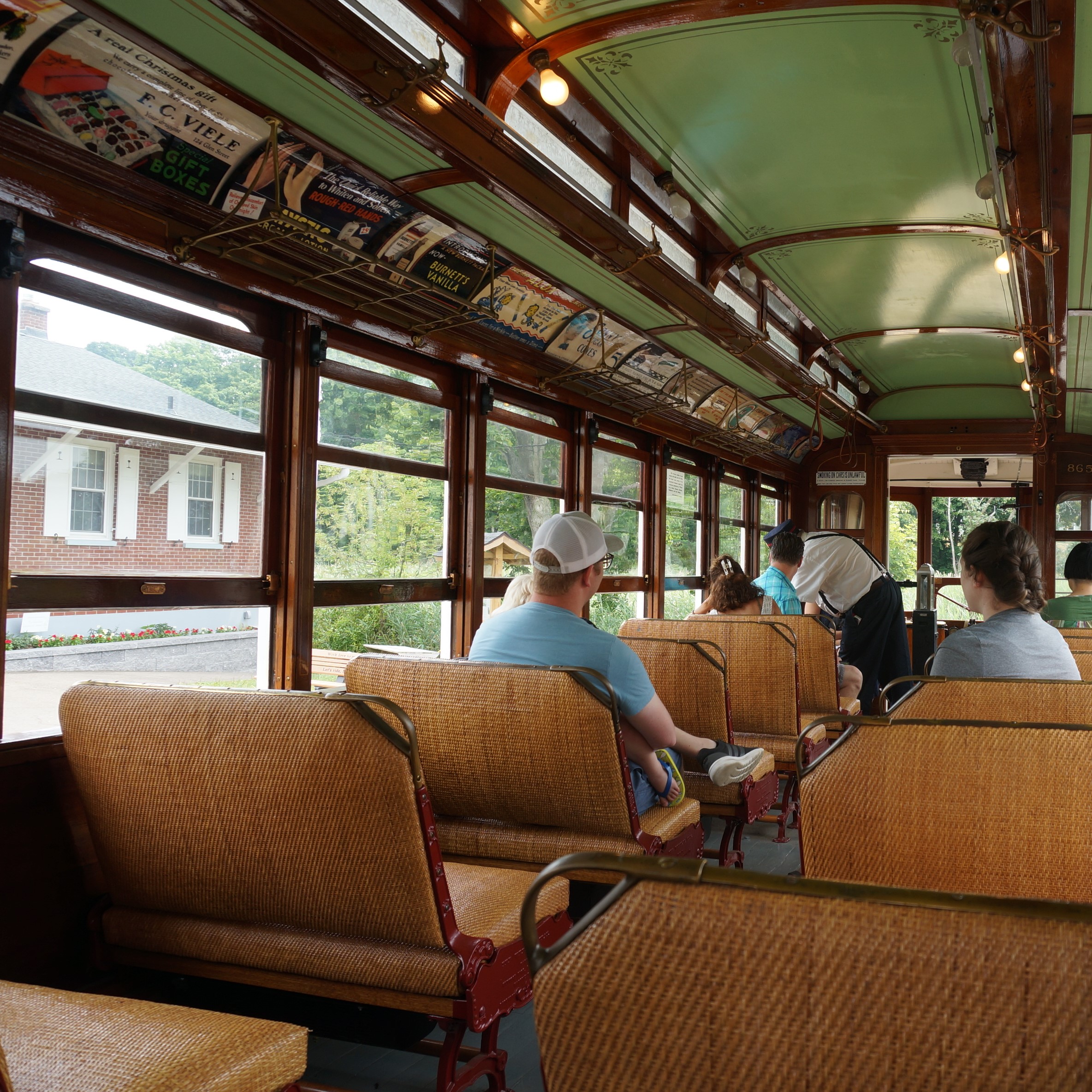
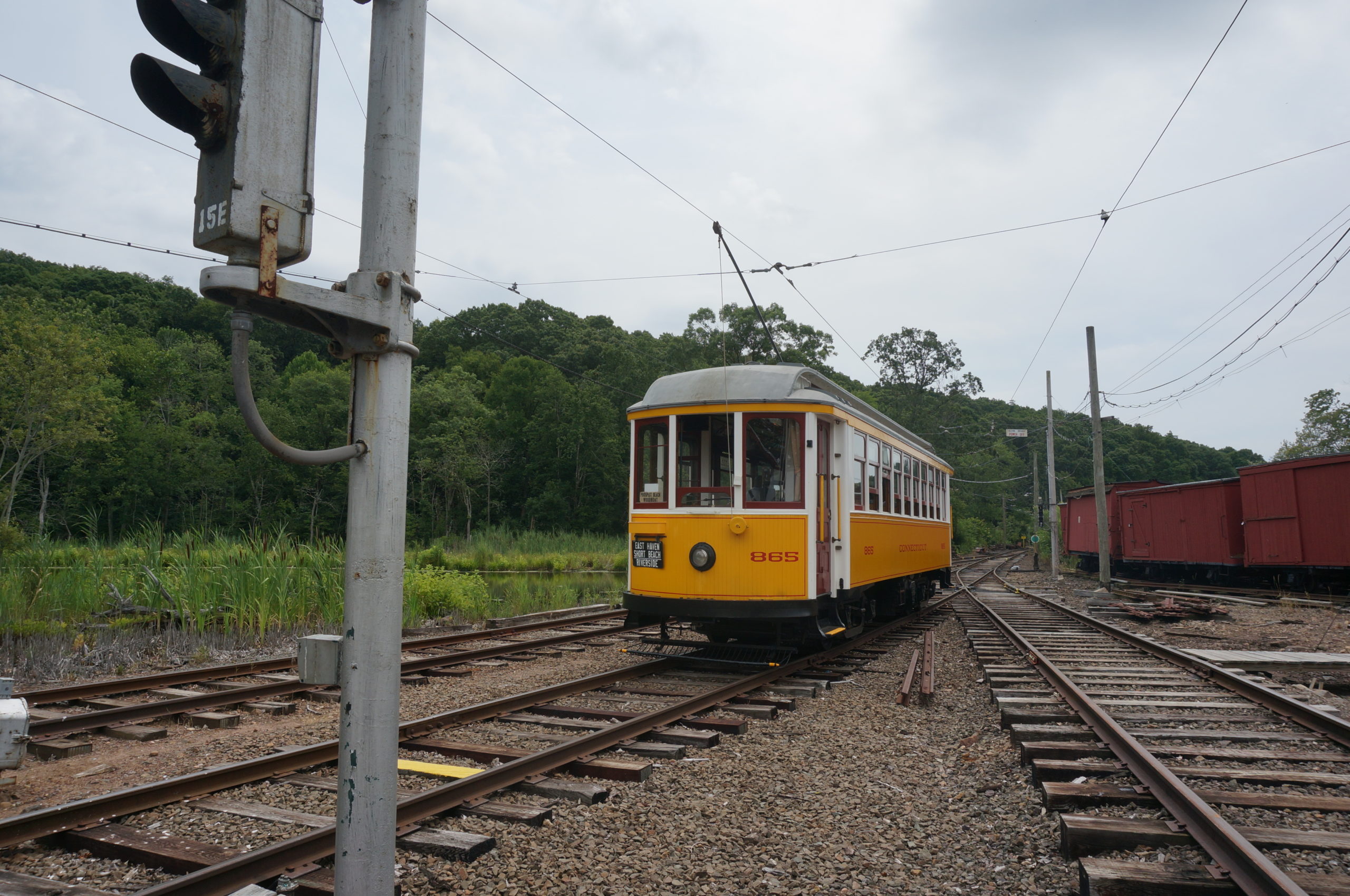
865 is a 1905 Wason,9 originally built for one of the Connecticut Company’s predecessors. It operated in suburban service. The collection website notes the luggage racks. Personally I’d note the midsize, clearstory roof, and the classic New England look. Its date of retirement is 1947, and I wouldn’t be surprised if it went directly to the museum.
Brooklyn Rapid Transit 4573
This is a 1906 Laconia.10 The most remarkable thing about this car, other than the tasteful purple color, is it being a convertible car. While convertibles are generally rarer in preservation, the Brooklyn Rapid Transit Company maintained a decently large fleet of these.
Well, what does “convertible” mean? The convertible was the development stemming from street railways often maintaining two sets of cars, open summer cars, and closed winter cars. This being uneconomical, convertible cars were devised, they were cars with large windows which would be removed in summer and installed in winter.
Looking at historical photos, the large fleet of such cars in Brooklyn seems pretty cool. In the museum’s collection, it is one of many New York cars, and a representative of one of its many systems and operators.
This car arrived in the museum after being converted to a salt car. I assume the restoration process was quite tedious because of that.
Exhibits
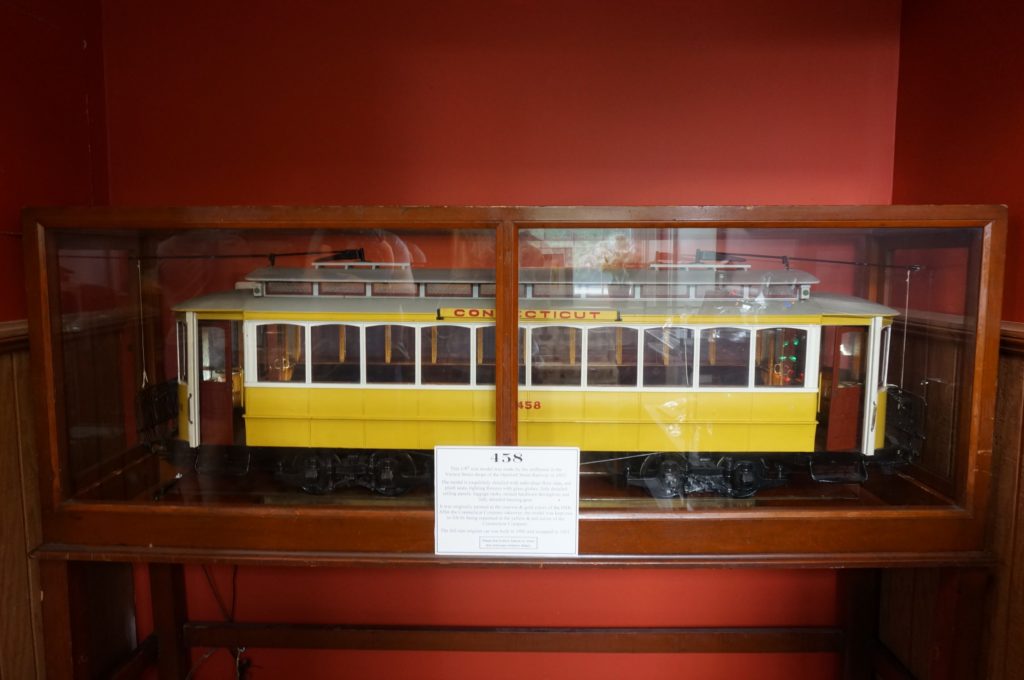
Visitor Center
The visitor center is a single story building containing a ticket booth, a small gift shop, a penny mincing machine,12 a room with general electric railway exhibits, and a nice and large Connecticut themed model layout.
Let’s take a look at that room:
Often, I find it hard to appreciate model layouts,13 but this one quite grabs my attention for being thought out and made with care.
Barn 1
Let us proceed towards Barn 1, also known as the Quonset Hut, probably because that’s what it is. The barn has three tracks able to host about two cars each. When I visited, there were four cars in the barn, with the middle track, the one passing through it to lead to the shop, being empty.
In my opinion, the most remarkable car inside the barn is Connecticut Company 500.
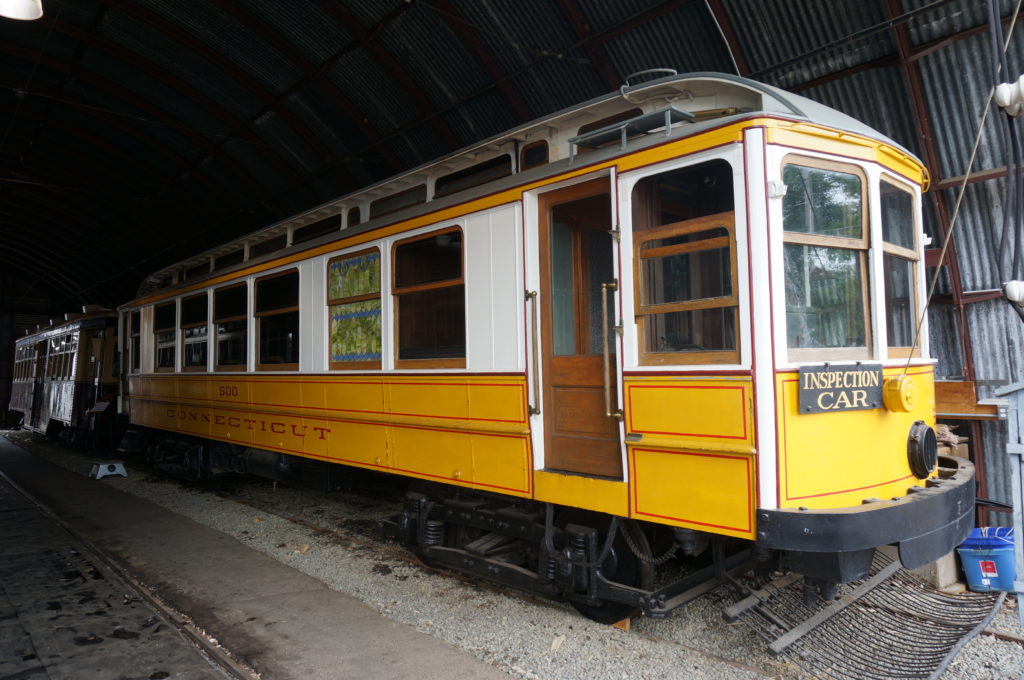
What makes it interesting? Well, the third window from the front may tell you something… It’s mosaiced? Mosaic windows are certainly unusual, and the door structure also tells you it’s not a standard car.
This car is in fact one of those “administration cars”, a usually one-off car constructed to transport company executives throughout the system. Sometimes these were used as meeting rooms, or available to charter.
This car comes complete with a minimalist kitchen, a restroom (that’s the mosaic window), a water dispenser, two enclosed driver’s stands on each end, and carpeted floor.
Forgot to mention, it’s a 1904 Brill.14
The next car in Barn 1 I’d like to mention is Third Avenue Railway number 220. The Third Avenue Railway is the second New York streetcar operator mentioned here, it served Manhattan, the Bronx, and Yonkers.
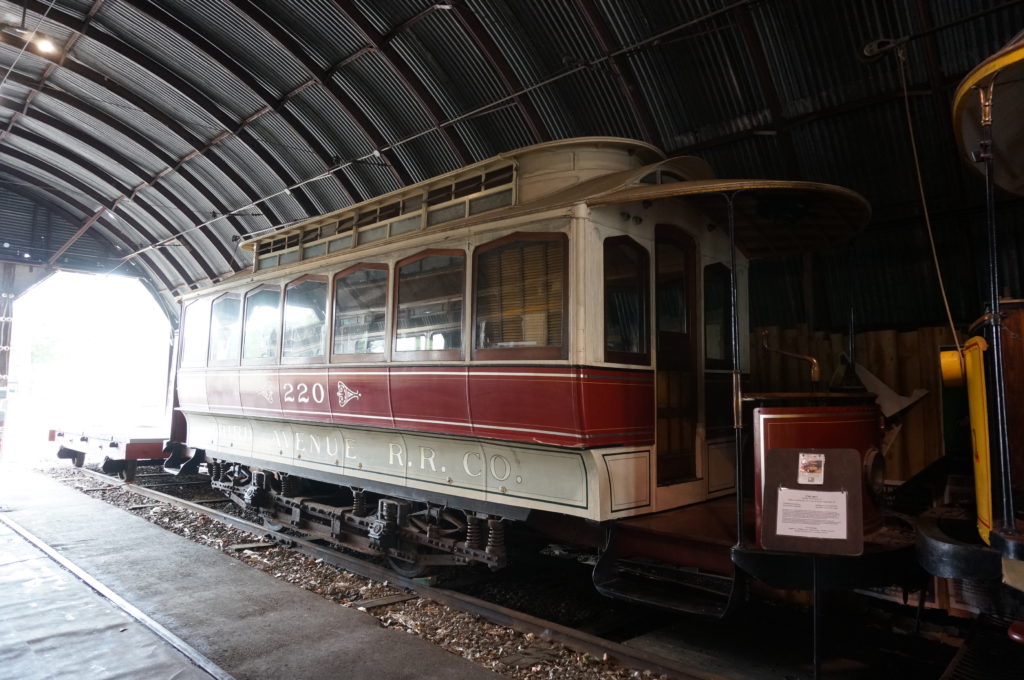
I kinda glanced over it, it looks interesting in my photos though.
Shoreline’s laconic collection website doesn’t have this car unfortunately. However, Shoreline’s other, less-laconic-but-still-laconic, collection website15 does have it. The information in there, as mentioned, is quite laconic.
It says this car was originally built in 1892 by the Laclade Car Company, which I hadn’t heard of and turned out to have been a somewhat short-lived16 manufacturer in St. Louis which was absorbed into the St. Louis Car Company. The car was built as a cable car and later converted to conduit (TARS was obliged to use conduit in Manhattan since overhead was banned there).
Manhattan was seemingly not a good place for single truck streetcars, as this car was converted to a conduit17 slot scraper in 1908 after less than 20 years of passenger service. The end of service of this car is cited as 1948, likely with the closure of TARS’ conduit system. It then went directly to the museum.
Barn 3
Let us now proceed to Barn 3, the second publicly open barn. As you can see on the map, it’s longer, but it has only two tracks, also giving you a grand total of 6 cars. This is the “operating” barn, meaning all cars in it are operational, and the missing space is filled by the operating fleet in the evening.
The cars in the barn are all standard, more mid/late conventionals, that doesn’t mean they aren’t cool though.
First I’d like to highlight Third Avenue Railway 629, it’s a late model conventional…
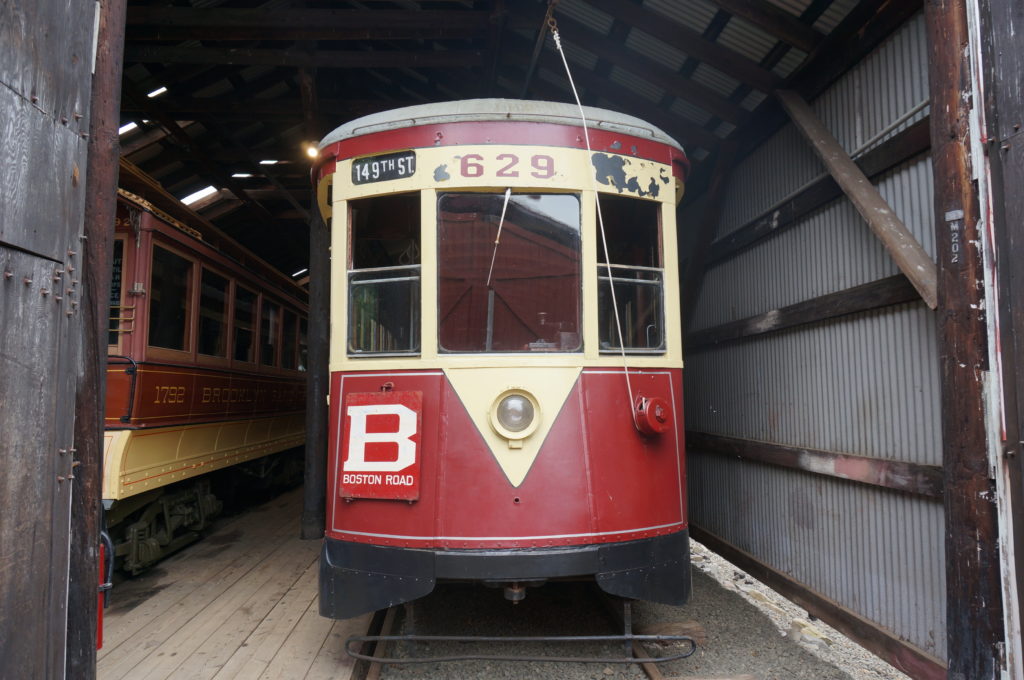
While it’s a bit unsuspecting at first, many of you may recognise these, and I think it’s fair to say they’re a fairly well known bunch. The story behind them is quite interesting, with a good insight into it being the builder/year combination.
This car was built by the Third Avenue Railway itself in 1939.
This may raise some eyebrows if you know the wider context, with two suspicious facts:
- It was built in-house
- It was built in 1939
Yes, that’s in fact all of the information, what’s so strange about it?
Let’s start with the 1939. By 1939, when this car was built, PCCs were already in production, and many had them on the order books. And if you weren’t getting a PCCs (say, you’re an interurban or you like Brill very much), you’d be getting what’s already classified as a streamliner, not a conventional. This puts these cars as antiquated during construction.
The second element of intrigue is of course the fact that this were built in-house. In North America, it has been and still is incredibly rare for something to be built in-house, and if it is, it’s usually heavy refurbishment, not full manufacturing.
It might be unsurprising, then, that these cars were actually rebuilds of earlier models. The full story is as follows:
Being short on funds and seeing the closure of its streetcar system imminent, the Third Avenue Railway decided not to acquire PCC cars, instead deciding on the refurbishment of their existing cars. These contained some modern features which you could also find on a PCC. In total 335 cars were rebuilt like this from 1934 to 1939. From my knowledge the cars were of different makes but somehow TARS managed to make them the same?
As said, soon after these cars finished construction, the city pushed heavily on the closure of streetcar lines, TARS’ Manhattan competitor, New York Railways, had already finished conversion to buses in 1936. Unfortunately for the city, World War II intervened. It was undesirable impossible to convert streetcars at that time due to the aforementioned prohibition of bustitution. But, World War II only hindered the seemingly inevitable, with TARS’ streetcar operations in New York City ending in 1948… and TARS railway operations completely in 1952, after the closure of some lines in Yonkers.
Logically you’d assume that some of these cars went directly to museums, and most were scrapped. But that’s not the case here.
In 1948, using Marshall Plan funds,18 Vienna bought 50 of these cars. It made sense. These were comparatively young cars, no American city would buy them, and they would definitely be better than nothing in alleviating post-World War II rolling stock shortages.
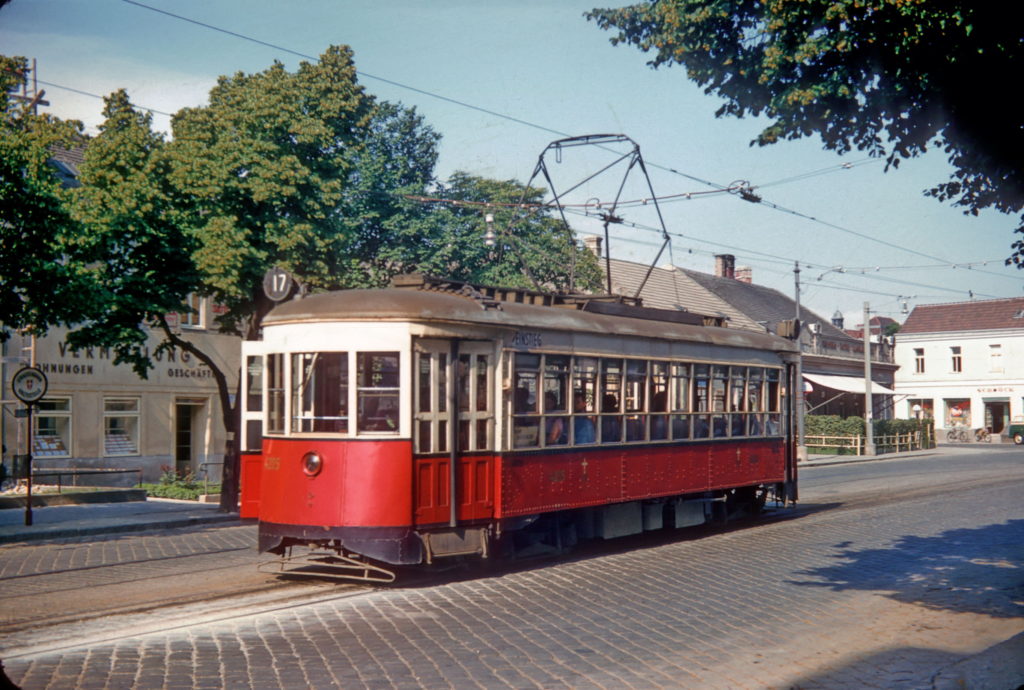
In Vienna, this type would be equipped with a sole diamond pantograph and be designated Тype Z. 629 specifically was renumbered 4239. These cars would be in service until 1969. It is important to note that due to their wide width, Vienna could only use them on suburban lines with wider track spacing.
Today, 629 is among about a dozen of preserved cars of this model. Most of them went via Vienna,20 and they’re distributed over a bunch of American and Austrian museums, plus the British National Tramway Museum (“Crich”).21
The other car at Barn 3 I’d like to share is the following:
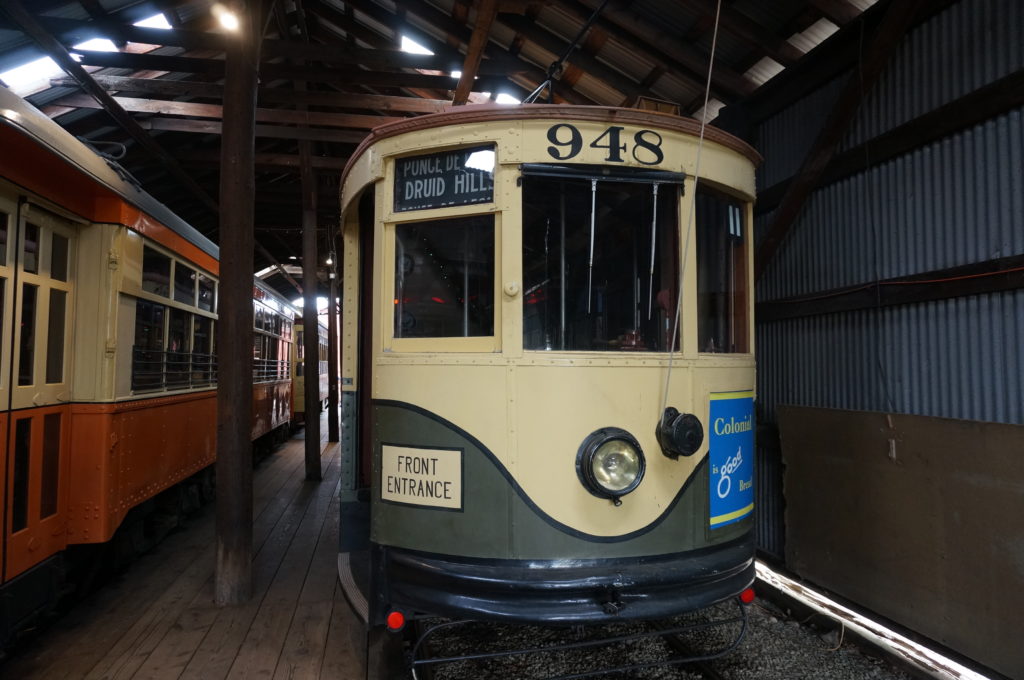
This is Georgia Power Company 948, also known as Atlanta 948. It’s also a late-model conventional, however fortunately not as outrageously unique as 629, being built by the Cincinnati Car Company in 1926. The Georgia Power Company was a utilities-first, streetcars-second company formed as the Georgia Railway and Power Company in 1902 as the consolidation of Atlanta’s electricity, steam, and street railways. The company renamed itself to the Georgia Power Company as these cars were received in 1926. To me, this relatively early renaming highlights that they caught streetcars were already not their main focus quite early.
Unfortunately, I couldn’t find more extensive information about this car and its series, but I’d like to highlight the nice curved doors on this car and the overall appearance.
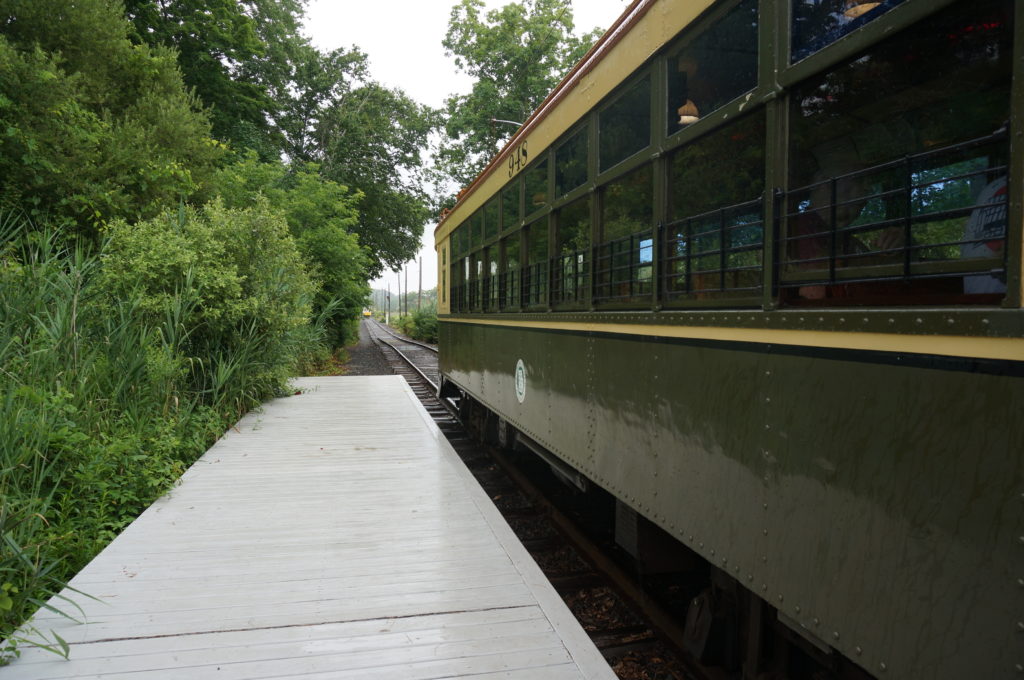
Atlanta closed its streetcar system in 1949 in favor of trolleybuses, which later formed a formidable system, which unfortunately no longer exists today either.
In 1950 the Georgia Power Company divested its transit operations and continues to exist today under the same name as a utility provider.
In either 1948 or 1949, as Atlanta’s streetcar operations were winding down, 948, along with a few other Atlanta streetcars, was sold to South Korea. 948 is said to have been dismantled for parts in Seoul. A few other streetcars also went to Busan.
I also had trouble finding information about what any of these Atlanta trams did in Korea.
Shoreline acquired the carbody in 1996 and restored the car by 2011. You definitely wouldn’t know on it that it was dismantled at some point in its life.
Barn 5
As you can see, Barn 5 is the third and final barn open to the public at Shoreline. For the most part, it’s a non-public general storage barn, except for one very specific exhibit.
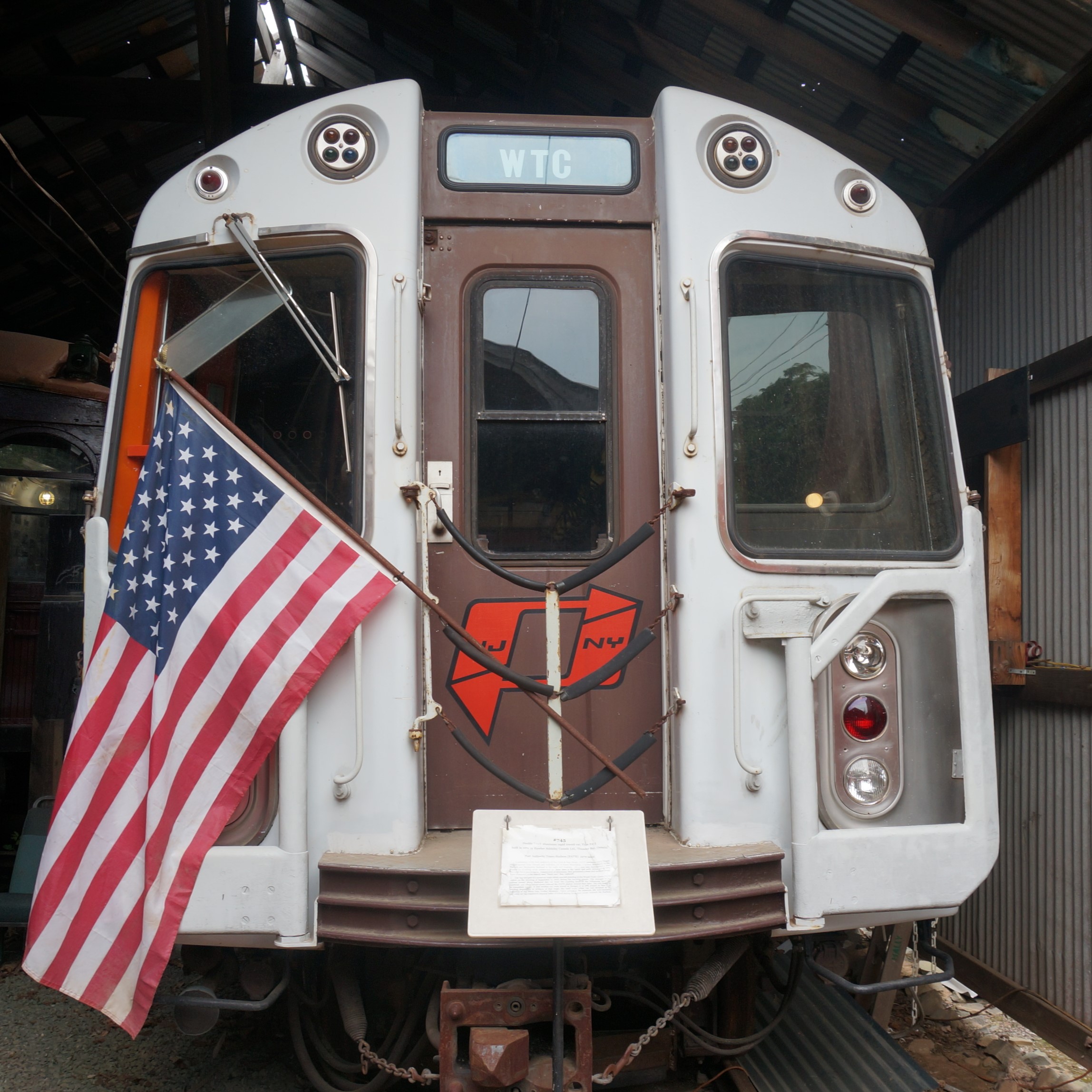
At the entrance to barn 5, two rapid transit cars are parked: a silver car, Port Authority Trans Hudson 745, and a red car, which should be Brooklyn Rapid Transit 999.
From a rolling stock perspective 745 may be unremarkable. It’s a Hawker Siddeley built for the Port Authority Trans Hudson (PATH) services of the Port Authority of New York and New Jersey, which are a subway system connecting Manhattan in New York across the Hudson to the conurbation on the New Jersey side and its rail terminals. The car was built in 1973 as part of a series of 46 designated PA3 replacing aging cars predating the Port Authority takeover. The PA3 series was part of four aesthetically similar series (PA1-4). Additionally these series are related to Boston’s Hawker Siddeley Stock.[blue line][orange line]
745 would’ve otherwise been an unremarkable car had it not happened to be in a consist idling at PATH’s World Trade Center terminal on the morning of September 11th, 2001.23 While the two other trains at the station at the time were ordered to depart, one on arrival without even stopping, this train was left standing in the station after its evacuation.
During the later excavation work it was noticed that, due to the structure of the terminal, car 745 and fellow PA1 car 143 remained practically intact. The cars were rescued and placed into storage with the intent of preserving them. It is said that they were offered to the 9/11 Museum, which declined them due to their large size. In 2015, car 754 made its way to Shoreline, and some time later 143 to the Trolley Museum of New York.
Currently 745 is on a memorial exhibit in barn 5. The car can be entered and the interior is said to have been untouched, however I presume it was cleaned, and if I recall correctly an article describing the car was inserted into one of the advert slots.
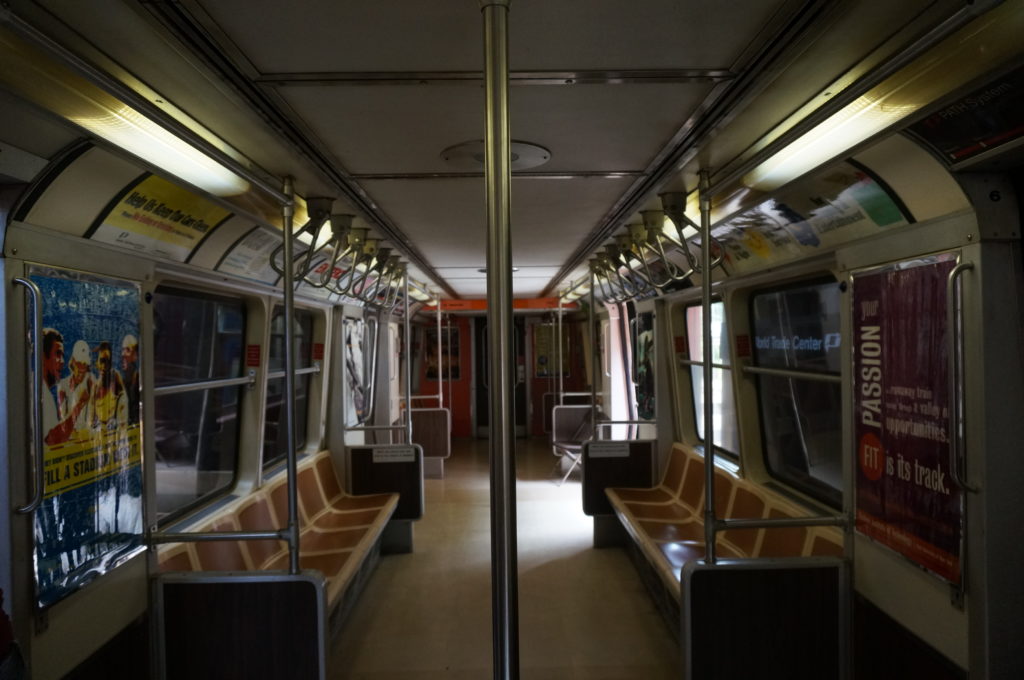
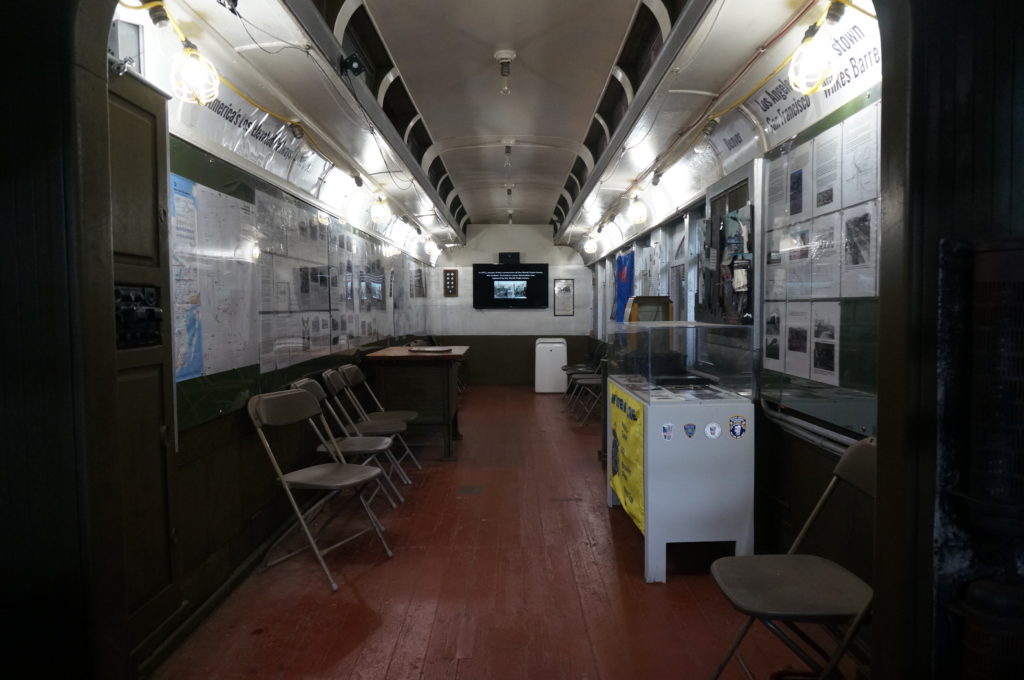
Obviously, in relation to car 745, Brooklyn Rapid Transit 999 is an auxiliary. In order to enter car 745, visitors must first walk through the car. The interior of car 999 is set up in two exhibits, one providing context for car 745, and the other dedicated to various elevated railroads in the United States.
The car itself is an elevated of wooden construction, and was built seemingly in-house in 1905 for Brooklyn Rapid Transit. It served as an instruction car, and passed down with the system through Brooklyn Manhattan Transit and the New York City Transit Authority. It is listed as having retired in 1961 and gone straight to the museum.
Extras
These are exhibits I saw that are not part of the regular museum visit, since they’re not currently open to the public. If you paid attention carefully, you’d note that I was visiting with well connected individuals,24 and they wanted to see these.
Restoration Shop
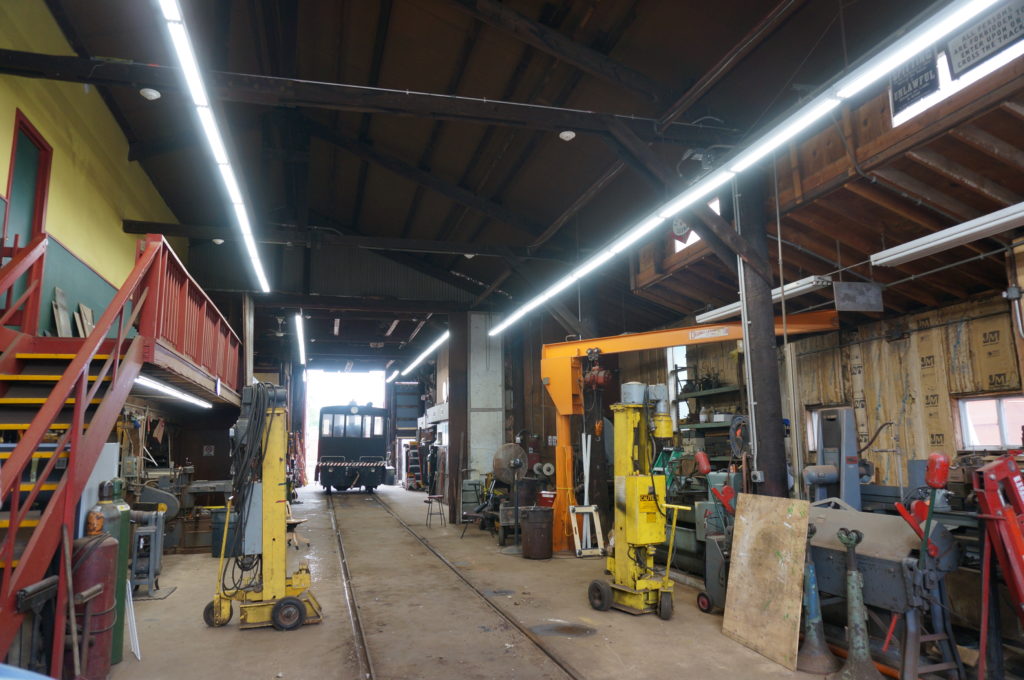
For such an impressive museum, Shoreline has a remarkably humble restoration shop: they must do impressive work in there. If packed, the shop could probably fit around four cars, three on the main track, and another one on the neighboring short pit track. The pit track at this shop is actually quite interesting, as it is on a trestle about 1.5 meters off the ground, with a dip in the floor under it. This is said to have been done like this because of the marshy location of the museum.
Barns 8 and 9
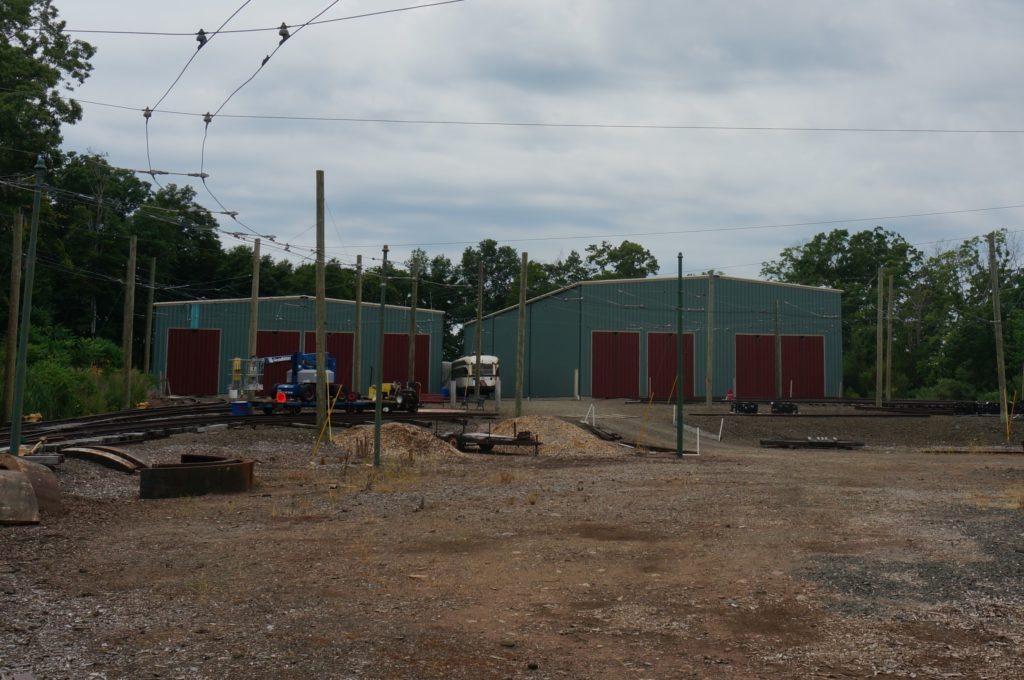
Barns 8 and 9 are the newest at the museum, as seen by their architecture. They are located more distantly from the main barn cluster. While not currently open to the public, Barn 8 is supposed to be a new exhibit barn, and 9 the new shop.
In my opinion, Barn 8 probably has the most interesting exhibits. If you visit, I’d say ask if it’s possible to see it, as most museums are friendly and will probably have somebody to guide you through it.
First highlight of the barns, this:
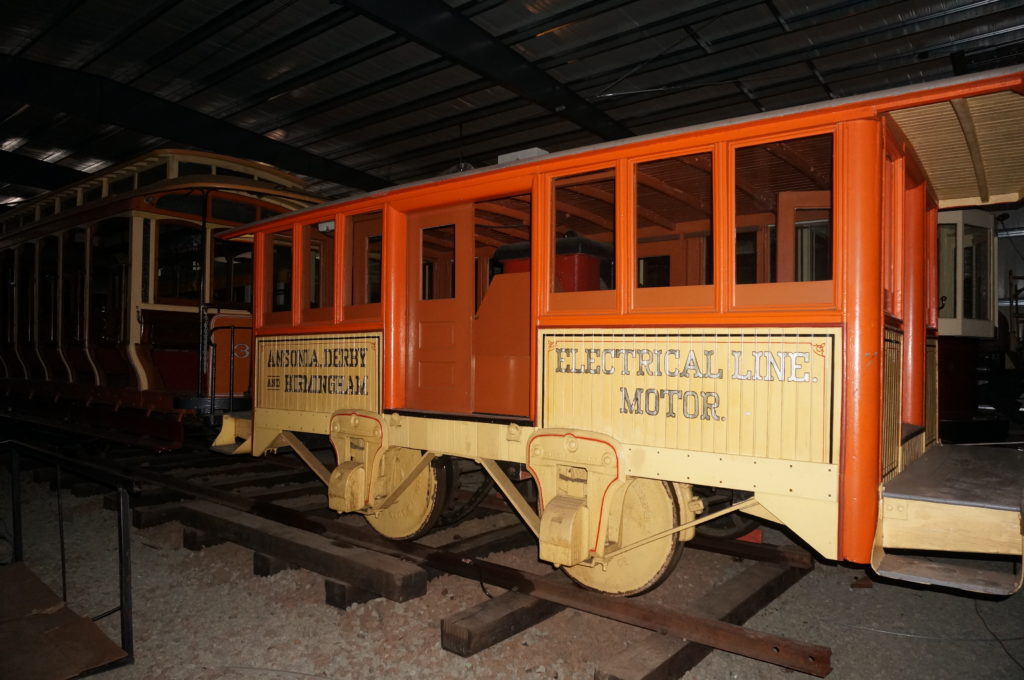
So, why am I showing this box to you? Well, I think we can all agree that this box is unusual.
This box is actually an electric locomotive built by Pullman in 1887 for the Derby Horse Railroad, an ironically all-electric railroad in Derby in southwestern Connecticut. Unsurprisingly the railroad later renamed to the Derby Street Railway. This locomotive, named “Derby”, was built for the railroad’s freight service, which started in 1888 and was discontinued in 1889, putting the locomotive at only one year of regular service.
The locomotive is notable for being the oldest preserved commercial North American electric locomotive, and the utilisation a Van Depoele motor in it. Charles Van Depoele is notable for being the inventor of the trolley pole,25 however, he also experimented with his own electric traction system, which involved a centrally located motor attached to the axles by a chain drive. This system later fell out of use for Sprague’s axle mounted motors.
An additional feature of this locomotive is… its box shape. Apparently, during the construction of the line, a mainline railroad bridge in the area was redesigned with significantly lower clearance, in order to block the streetcar line. Evidently, the Derby Horse Railroad did not give up and designed short rolling stock to cope.
The Derby Street Railway, through a series of mergers, ended up with Connecticut Railway & Lighting, and later the Consolidated Railway and the Connecticut Company. Throughout its tenure with Connecticut Railway & Lighting it was put up for public display in a park, and with ConnCo it was stored in a shop. Later the locomotive was transferred to the New Haven Railroad where it was restored and displayed for special occasions. In 1950 the locomotive was once again transferred, this time to the Danbury Fair who displayed it annually. In 1982 Shoreline was able to acquire the locomotive and restore it to operating condition. I am not sure if I want to see this operating…
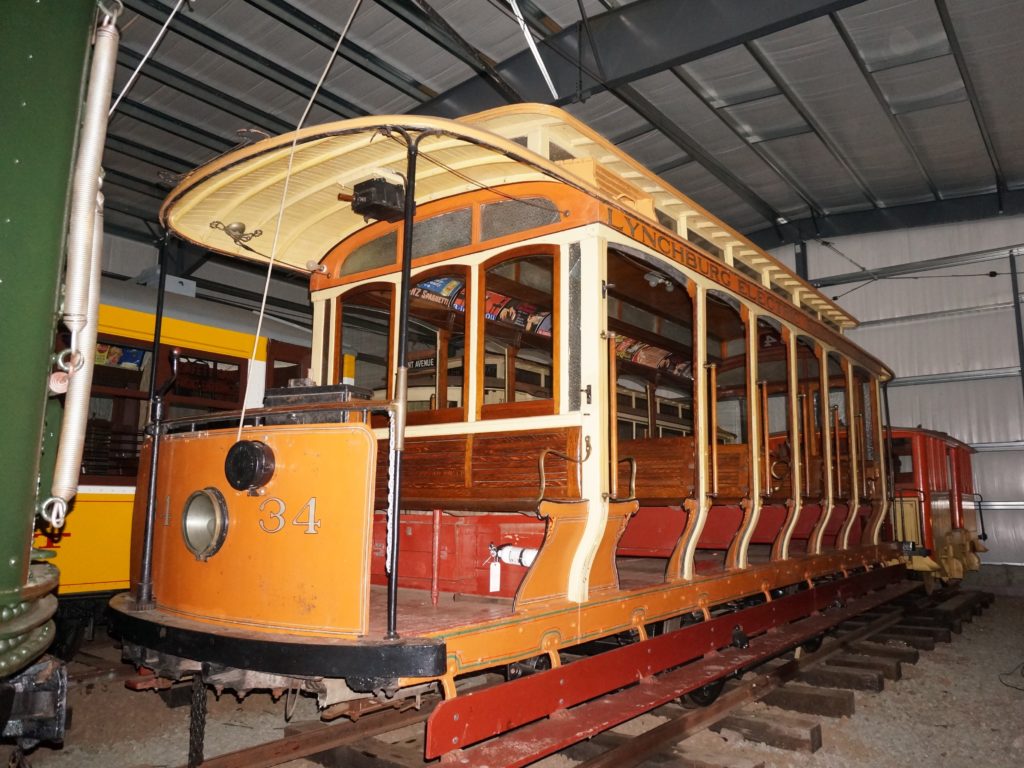
Next, as you can observe, right in front of the Derby, there is another interesting car, Lynchburg Railway 34.
This is a cute single truck open bench car built in 1899 by Jackson & Sharp for the Lynchburg Railway of Lynchburg in central Virginia. The single truck design seems to have been popular with smaller city streetcar companies and there aren’t many left around, so it very nice that the museum has it in this condition, which I believe is operational.
In 1929, following what I presume is its service in Lynchburg, the car was purchased by the Five Mile Beach Electric Railway of Wildwood, on New Jersey’s coast. To me, this seems like an unusual acquisition, and it looks like Five Mile was a resort town operation, so they had a strong incentive to maintain open cars.
The Five Mile Beach Electric Railway switched to buses in 1945, and BERA was able to acquire the streetcar directly from them, putting this as the museum’s first car. The museum doesn’t really make a big deal of this, and as you can see it wasn’t on public display when I visited.
If I had to guess, I would say that this car was probably chosen as the first car to be acquired since it was a surviving bench (open bench cars were exceedingly rare in operation by the late 30s and 40s), and open benches would’ve probably been popular with visitors. It is also possible to draw similarities between this car and Seashore’s first car, which was also a resort town bench.
Now, we will finish our look at barn 8 with…
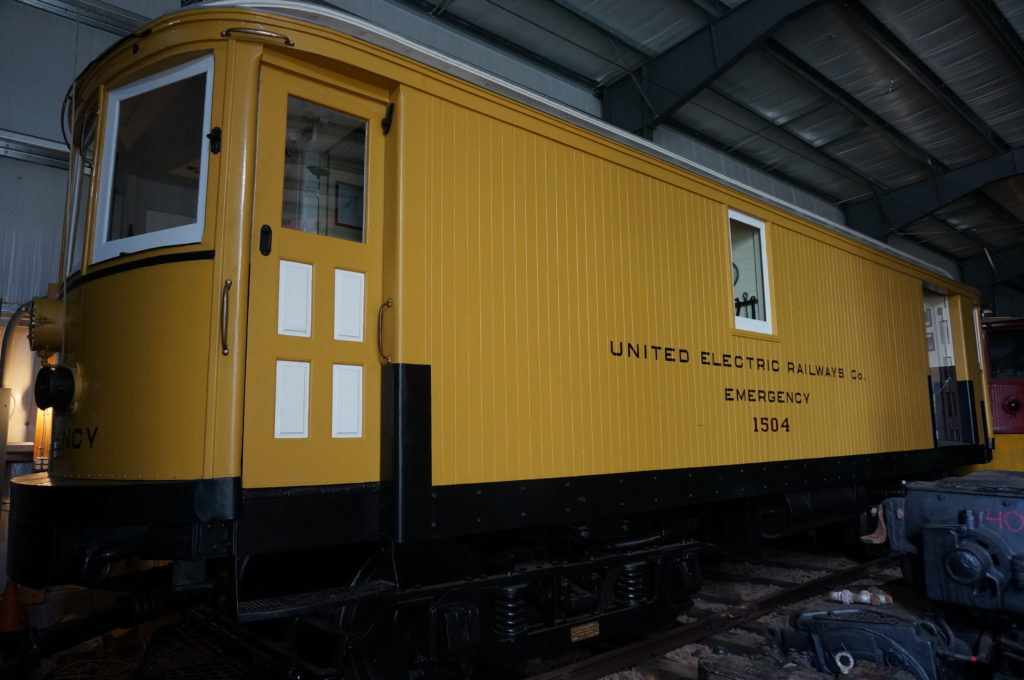
This car is Rhode Island Company 1504. As you can guess by the name, the Rhode Island Company was also a big conglomerate controlled by the New Haven Railroad, who had a strong appetite for street railways in southern New England. This car was built in-house in 1904 to serve as an emergency response vehicle and as a tow. The inside of the car was full of repair tools and currently contains an exhibit regarding its history, however as you can see the exhibit is not currently on display. Personally I just think the car looks cool, and I have also not encountered something like it before.
The Rhode Island Company filed for bankruptcy in 1918 and was reorganised as the United Electric Railways in 1919, which is why the lettering on the car is like this. The car was donated to Shoreline in 1948 where it has historically proved useful as a tow.
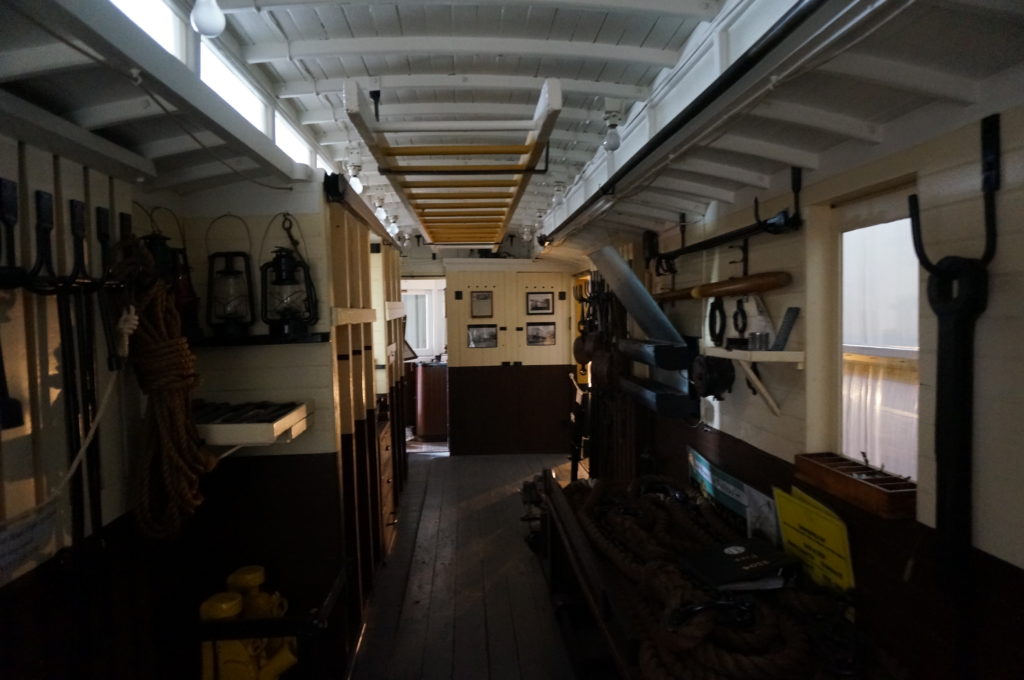
Now, we move on to Barn 9. Barn 9 had a less interesting assortment of vehicles at the time in my opinion, so it only gets one car on this overview.
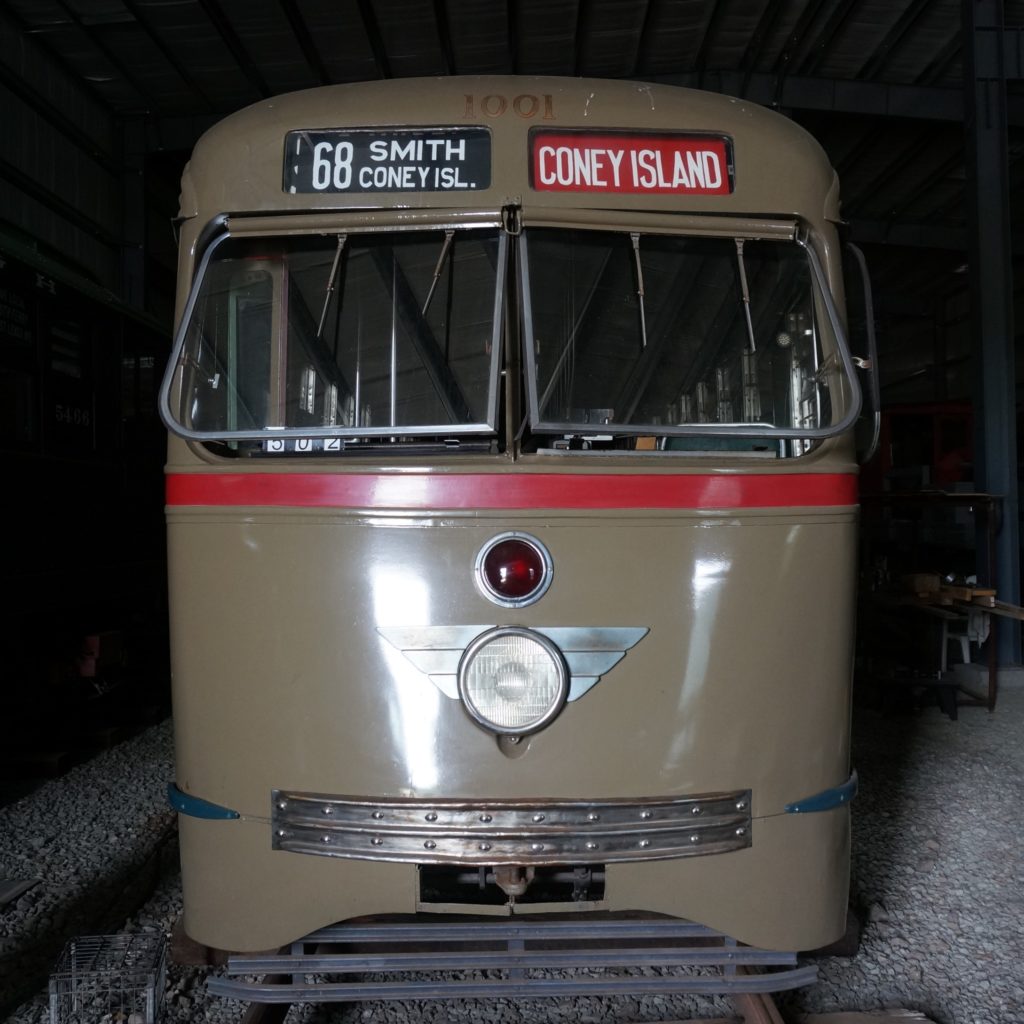
From simple observation it can be deduced:
- It’s a PCC (streamlined shape, distinctive headlight and windows)
- It’s a funny color (beige-olive, who paints anything that color?)
- It likely served in New York (Coney Island destination sign)
Well, it might be exciting for you to learn then, that this car, Brooklyn & Queens Transit 1001, is the first production PCC ever. While we never associate PCCs with New York, TARS, after all, never acquired PCCs, the first production PCC did in fact go there, however not to TARS. Brooklyn & Queens Transit was Brooklyn Manhattan Transit’s subsidiary for streetcar operations in Brooklyn and Queens. B&QT was one of the first to order PCCs following their testing of proto-PCC equipment.26 B&QT only ever operated 100 PCCs, numbered 1000 to 1099.
This raises an interesting note, because despite being the first production PCC, it wasn’t B&QT’s first by numbering. This is since B&QT ordered 99 cars from the St. Louis Car Co., and one car from the Clark Equipment Corporation, the only PCC ever produced by them, which was car 1000 and preceded the St. Louis cars in numbering.27
Additionally, despite the significance of being the first production PCC ever, 1001 was neither the first PCC delivered nor the first one in revenue service, as Pittsburgh‘s number 100 beat it to that.
The car was acquired by the museum in 1956 from the New York City Transit Authority after being in storage a few years following the closure of Brooklyn’s streetcar system.
In summary, it can be said that this car is extremely significant but somehow not entirely, being the first to many things but only in a unique way. To add to the impression, it and number 1000 are the only New York PCCs to be preserved.
Conclusion
Finally, even though it took me a long time to write this, it doesn’t take away from my appreciation of Shoreline Trolley Museum. The museum’s East Haven location makes it easily accessible by both public transit and automobile, in addition to the airport being quite nearby, if you care about that. Personally, I would dedicate a full day for visiting, however, you could probably make a quicker visit. Make sure to check their website, for accurate opening hours, as I had a lot of trouble finding those. Maybe try calling them, too.
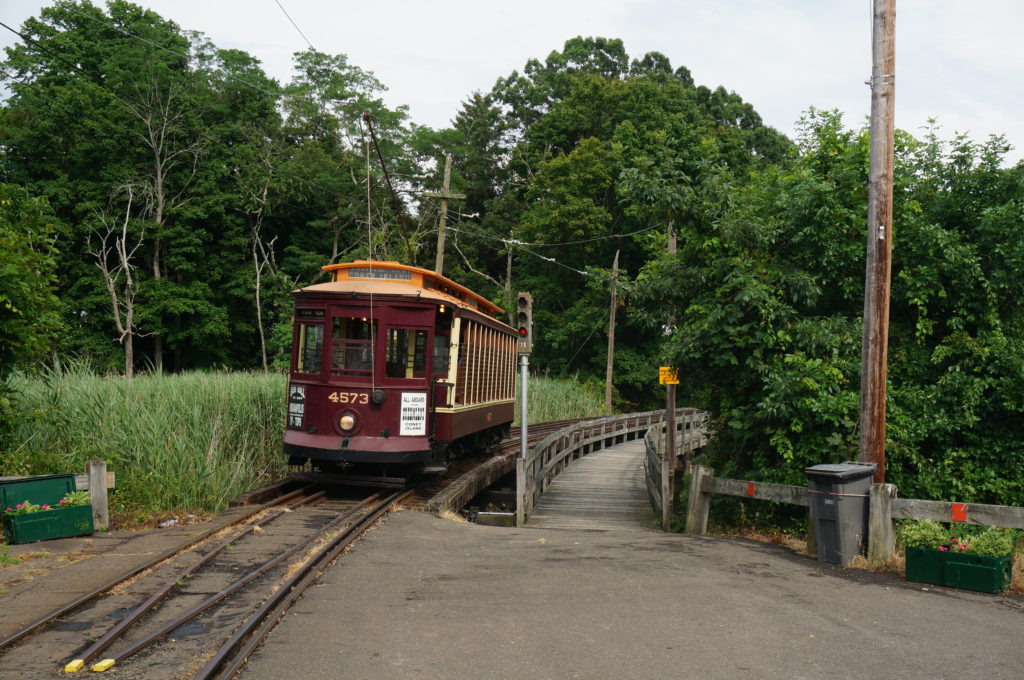
Sources
- Georgia Power: History of Georgia Power (PDF)
- Google Maps
- Mid Continent Railway Museum: Laclede Car Company
- New South Associates: Historic Streetcar Systems in Georgia: The Georgia Power Era
- The New York Times: A 9/11 Artifact Heads to Its New Home at Connecticut’s Shore Line Trolley Museum (5 August 2015)
- The website of a Seashore Trolley Museum:28
- The website of the Shoreline Trolley Museum:
- The other (“member”) website of the Shoreline Trolley Museum:
- [in German] Tramways.at: Triebwagen der Wiener Straßenbahn
- The Trolley Dodger: Five Mile Beach Electric Railway (PDF)
- Untapped New York: Last Two WTC PATH Train Cars From 9/11 Will Open to Public for First Time (date unclear)
- Wikipedia:
- PCC From Coast to Coast, (1983) Fred W. Schneider and Stephen C. Carlson. (ISBN 0-916374-57-2)
- Streetcar Lines of the Hub: The 1940’s, (2003) Bradley H. Clarke. (ISBN 0-938315-05-6)
- Trolley to the Past: A Brief History and Companion to the Operating Trolley Museums of North America, (1983) Andrew D. Young. (ISBN 0-916374-56-4)30
We hope you have enjoyed this post, if you have any questions, comments, feedback? please do not hesitate to comment or contact us.
